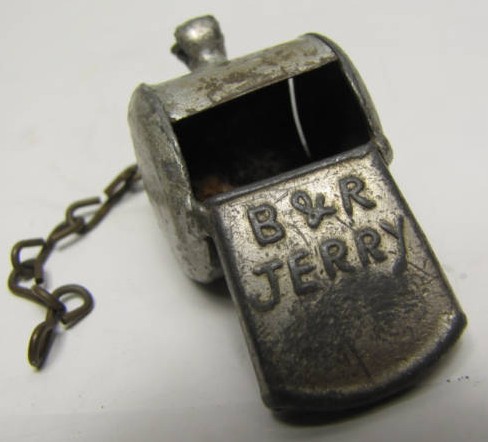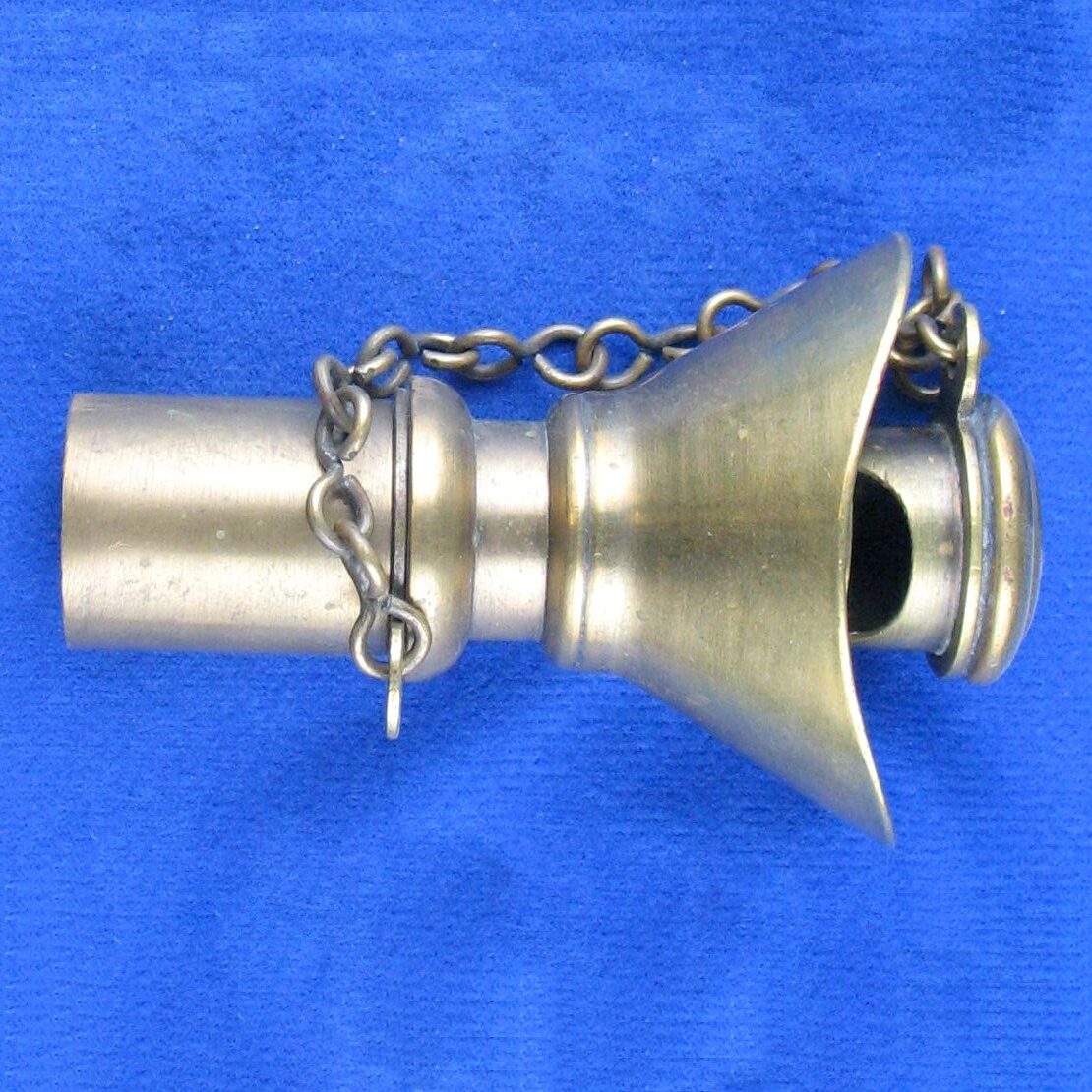Spotlight > Specific Manufacturer > United States > B&R > 086
In celebration of TWG's one-millionth page load …..
B&R Whistles
B&R whistles have been omnipresent in the USA. Whistle collectors have long wondered where they were made, where they were manufactured, how old they are ?? In the UK and some other countries known for their accessibility to whistle manufacturers’ business records, closer geography and locality facilitated research. However the United States is very large in geography and this inhibits on hand research of micro phish, city records, stored literature and the like. Fortunately the internet has changed things. We can from afar dig deeper.
After many years of on line published research material, electronic postings and whistle gathering things have come to light. We would like to propose that Behrend & Rothschild was the distributor of B&R whistles. Apparently they were not a manufacturer of whistles at all, leading to the enigmatic nature of researching them. It would appear that Waterbury Manufacturing supplied them with unibody scout whistles at first ( possibly other models ). Other manufacturers may also have been contracted.
Beyond this, Strauss and Brothers Company are attributed with being the sole selling agents of their unibody scout whistles, once again a most difficult company to trace.
B&R was possibly the second most prolific whistle distributer in U.S history, second only to BGI ( Bridgeport Gun Implements ), B&R whistles are credited with at least six different models prior to World War II. During this time period and from such a time major whistle manufacturing companies such as Gotham Metal Works, Colsoff and the American Whistle Corporation, would grow.
BGI for a certainty manufactured the most variety ( see SPOTLIGHT #44 ) starting before 1880 and closing prior to world war one ( Union Hardware at that time bought out BGI ), B&R took up the mantle The variety of models would taper off as time went on though, even if production may have increased.
World War II becomes a pivotal point in manufacturing history in the USA. Conclusively it also becomes evident that in their later years approaching World War II that B&R went under new ownership as businesses closed and others opened and appears to have changed their suppliers and contracted out their whistles to Japan, possibly Germany, the UK or possibly all three. In this change the overall quality of their whistles dropped dramatically.
This being said, we will look at two major periods for B&R.
1) The first period will encompass 1910 to 1945.
2) The second period from 1945 to circa 1953.
We have made every effort to cite bibliography so as to substantiate our research. At the same time all our research and records have been filed here at the reference collection database for any questions that may arise. Please feel free to challenge anything we may have stated erroneously. There is no profit being made and all our research is free for the public to study beyond that this article is copyrighted.
WHISTORY
Albert BEHREND — was head of B & R
Born – Aug 1859 in Wash. D.C./ Death – March 7, 1921
Joseph R. ROTHSCHILD.
Born – unknown/ death unknown ( alive 1896 – to 1916 recorded with a patent )
( A. Behrend’s background entailed decades of work at Tower Manufacturing and Novelty Co. )
1896 Behrend and Rothschild established
1897 listed in Trow’s at 355 Broadway
1906 patent from Coller assigned to Behrend and Rothschild
1911 Behrend and Rothschild – Strauss Bros Sole dist. Scout unibody first advertised whistle
1913 Albert Behrend – Connected with B & R & Tower Manufacturing and Novelty Co.)
1921 Albert dies, ownership goes to Jerome Behrend, Joseph Rothschild, Claude Coller
Jerome Bernard BEHREND ( son )
Born March 16, 1886 / death May 18, 1963
Claude C. COLLER and Joseph Behrend listed as composing B&R in a coin machine patent )
In 1900, Claude C. Coller and his 23 year old wife were boarding with the Albert Behrend family in their home located at that time in Brooklyn. Claude’s job was listed as being a bookkeeper for a factory merchant.
1936 listed on 114-120 East 23 street New York
1938 lists Behrend and Collier on a coin patent
1941 listed on 114 East 23 street New York
1943 patent assigning Behrend and Coller only.
1953 listed as half owned by William Stayback ( owner of Lee manufacturing Co. – coin rides ) name
now listed as B&R Novelty Co .
1953 listed as supplying the National Kiddie Ride Corporation (Fred Raffinello partners with two others)
1953 Fred Raffinello president of B&R Novelty Co.
Also listed in their advertisements is a factory in Greenpoint Long Island the further most point of Brooklyn.
A rubber factory 256th north 10th street
It appears that B&R wholesaled ( and retailed ? ) whistles from at least 1910 to as late as the 1950s, ending post WW2, eventually going to less expensive manufactured whistles.
Here a Bigelow and Douse advertisement pictures a Cyclone escargot as early as 1910.

'B&R for all its existence was known mainly as a toy and novelty manufacturer. They sold their products wholesale through the services provided by the Strauss Brothers from at least 1911 through as late as 1943. Their specialty was mechanical toys and coin banks. In 1938 they worked with the Walt Disney organization to produce a special coin bank featuring Snow White and the Seven Dwarfs. A new coin bank featuring Dopey was brought out the following year. All of their coin banks were designed to take dimes ( and pennies too it turns out ). The first dime placed in the bank would lock the door and upon the deposit of the 50th dime, the door to its riches could now be opened. All B&R products are highly collectable. A working toy, in good condition can bring prices of over $2000.’ – (Courtesy of Dan Shouse)
Sole selling agent can be appointed for some products or whole category of products by the company.
They had patents related to drinking cups, balloons, tin toy figures, staple rubber goods, druggist sundries, and especially banks. Ownership would eventually take business into children’s rides and merry-go-round rides..(Research Courtesy of Dan Shouse)
The first recorded scout whistle is an advertisement from 1911 the same year that it was patented. Interestingly, William H. Burt patented this whistle September 5, 1911 and assigned it to the Waterbury Mfg. Co.– 96 miles away in Connecticut. A 1941 advertisement among others lists Waterbury Button Co. as a supplier of whistles. Waterbury Mfg. Co and Button Company overlapped.
The questions arise:
- Did Waterbury make ALL the whistles for B&R ?
- Did Waterbury manufacture the escargot advertised the year prior to the 1911 scout whistle ?
- Who manufactured the duplex and triplex whistles ?
- Was B&R a wholesaler of whistles only ?? Strauss and Brothers Company are advertising at the time as the SOLE distributors of this whistle.
Although a manufacturer of tin type mechanical toys and perhaps rubber products like balloons, whistles were apparently stamped with B&R for distribution purposes only.
Behrend and Rothschild 353-357 Broadway, New York
Behrend and Rothschild 114-120 East 23, Street, New York
Strauss and Bros. 353-357 Broadway, New York ??
Tower Manufacturing and Novelty Co. was located at 350 Broadway
The logo of the Behrend and Rothschild Co.- pair of wings, B&R in a circle junction of two wings

Here following is a 1911 advertisement for the unibody scout whistle. We note here the reference to Strauss Brothers and Co. as the SOLE selling agents.
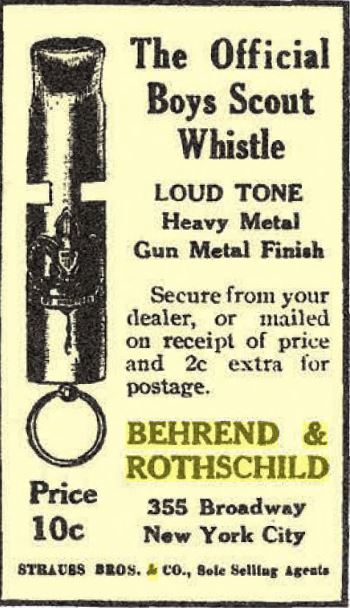
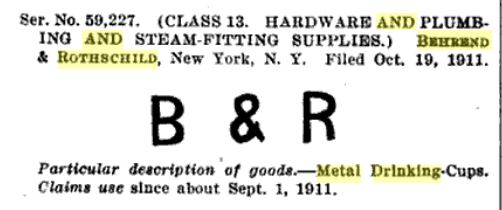
WHISTLE ARCHEOLOGY
In examining the patent against found whistles a match does not exist where the four penetrations are shown in the patent drawing. We have one without any penetrations and all the rest with three. Note point 8 in the illustration.
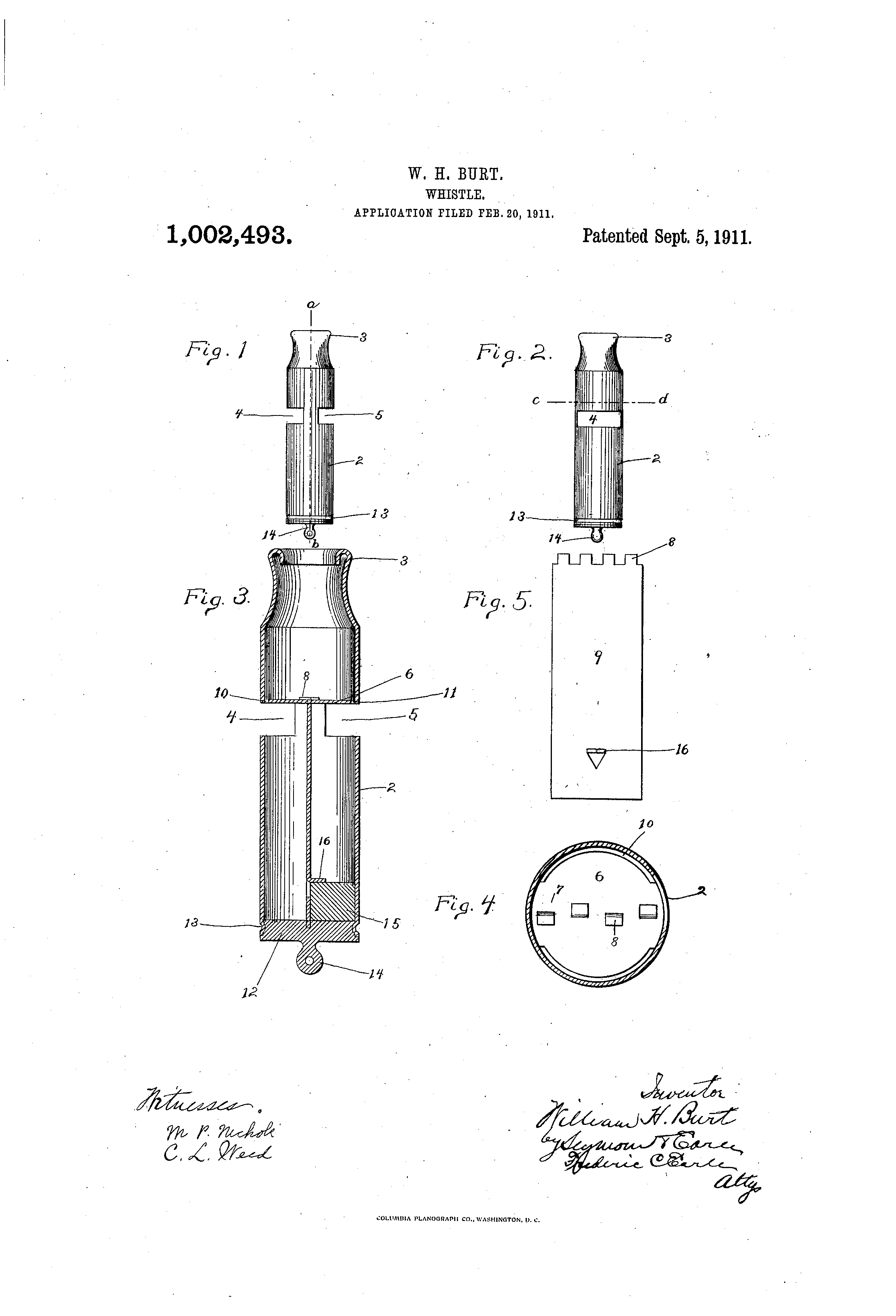
It has been our experience that most unibody scout whistles we have seen have had B&R stamps on girl scout whistles and not on boy scouts.
B&R Whistles:
1910 — escargot
1911 – unibody
1910 ? – duplex
1910? – triplex ( flat arrangement of tubes )
1910 — tube shaped with heavy tops and mouthpieces
1910 ? – thin wall sirens
Known stamped issues:
FIRST PERIOD
Escargots:
B&R Cyclone ( round knop )
Cyclone Police ( round knop )
Thunderer Made in USA ( grooved top cap )
Sportsman Made in USA ( grooved top cap )
B&R Cyclone Made in USA ( grooved top cap )
Regulation U. S. Army Solid Brass ( grooved top cap )
unmarked ( grooved top cap )
Regulation U..S. Army Solid Brass ( flared top cap – no groove )
Meyers ( side stamped ) ( flared top cap – no groove )
Chien Thang C.L.V.N.C.H. ( flared top cap )
Duplex & Triplex:
B&R
unmarked
HeavyTube Shaped:
unmarked
B&R
Rancho Cigar Am-Exchange Cigar C NY
Metropolitan Fire & Police Whistle B&R
***** Metropolitan fire & police whistle B&R – made to the Burt patent
Municipal Police USA B&R
Compliments of The New York Evening Telegram
B&R City Police & Fire Whistle
Light Tube Shaped:
B&R City Police & Fire Whistle
Siren:
B&R
SECOND PERIOD
Escargots:
B&R Jerry No. 2550 nickel plated brass
B&R whistle ( brass ) – ( Japanese ?? )
B&R Jerry ( zinc )
B&R ( small ) — ( German ? )
Duplex:
B&R Duplex, made in USA – plastic
TRIPLEX
unstamped – plastic
————————————————————————————————————————————-
First let’s examine Burt’s patented design assigned to the Waterbury Manufacturing Co. It was patented in September 1911, yet advertised that same year for B&R. Here is a boy scout and girl scout pair. And a U.S. Army stamp. There are two stamped logos for the boy scouts with slight variations.
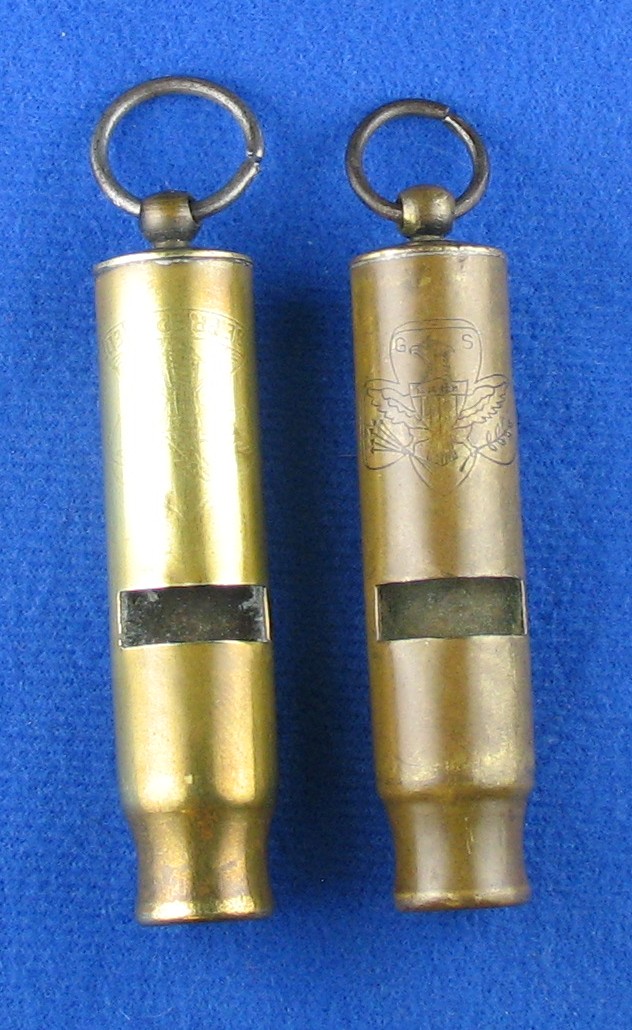
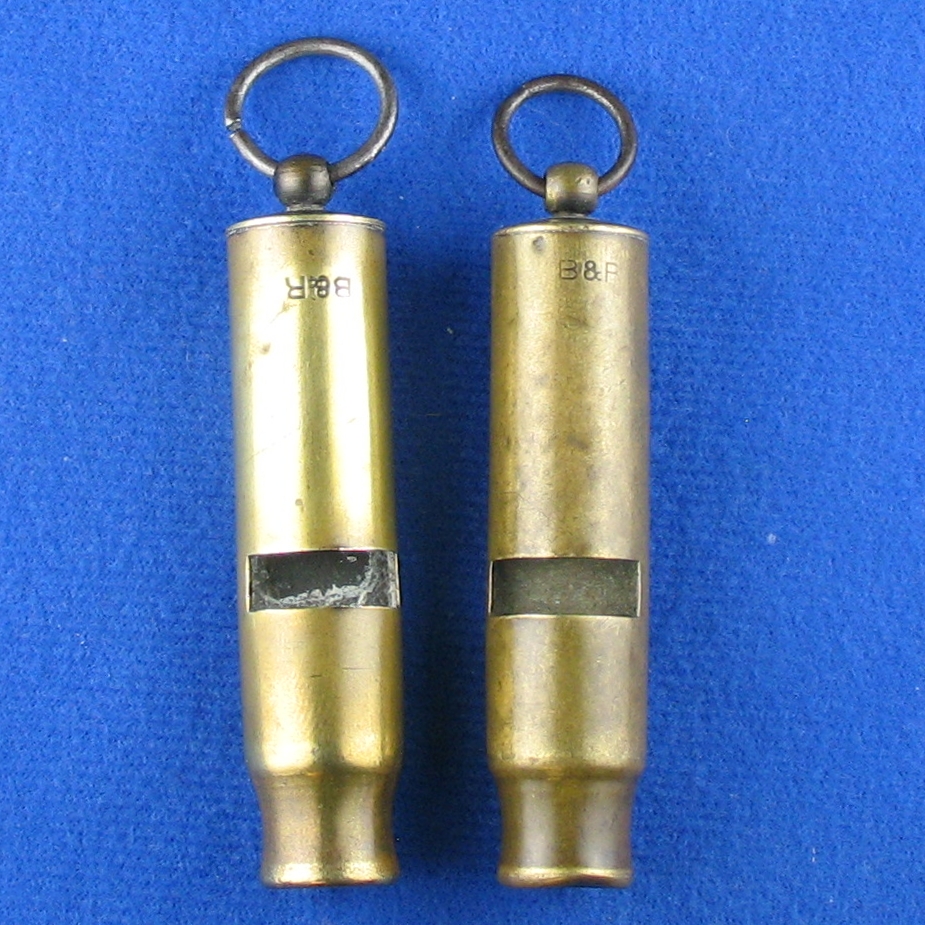
One whistle has been found without Burt’s patented penetrating teeth through the disc. ( Not pictured )
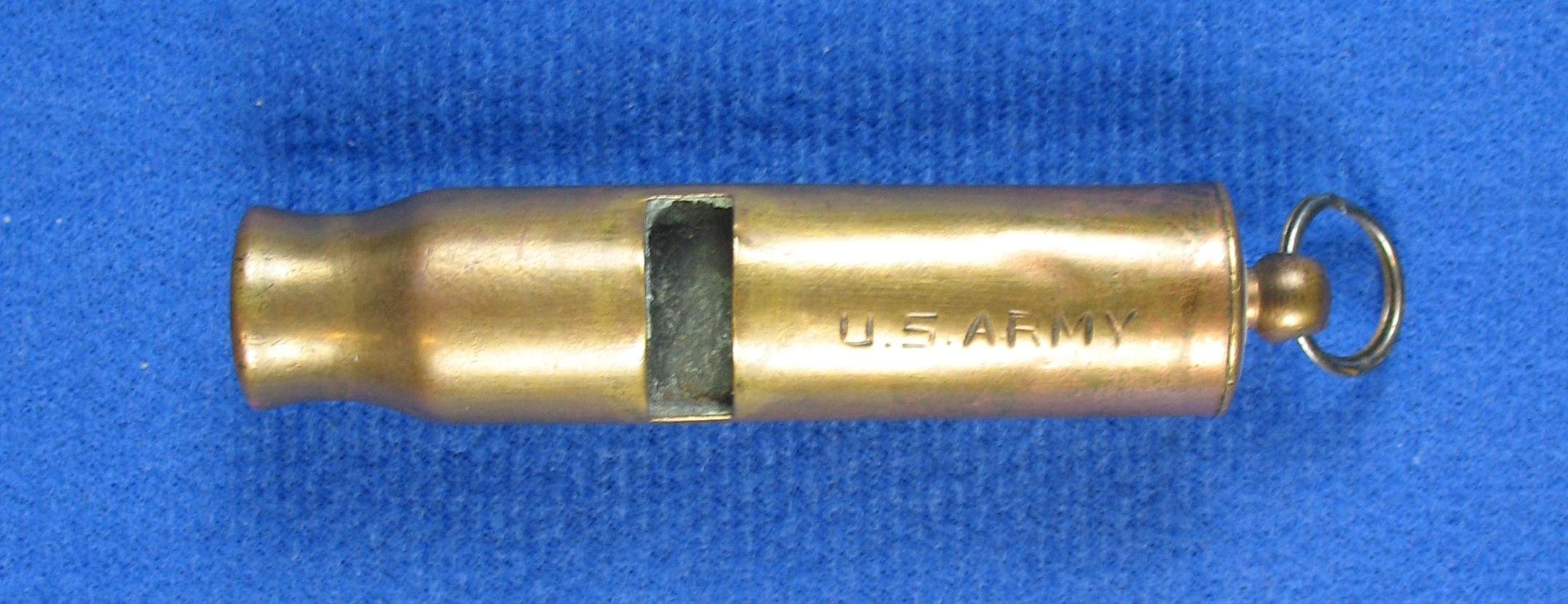
Next is presented the often seen B&R Cyclone and a Cyclone Police escargots circa 1910
Both whistles are confirmed as B&R.
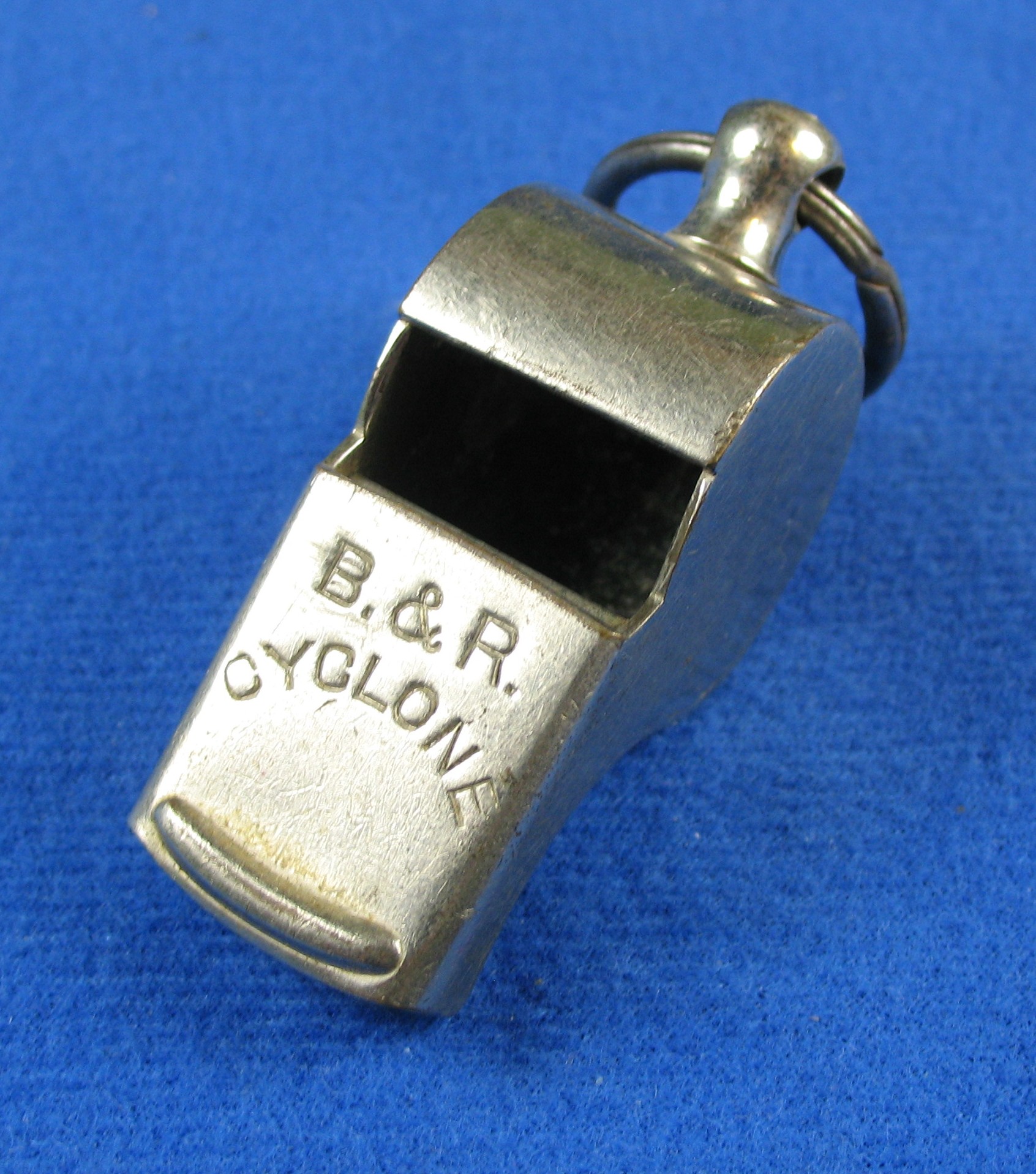
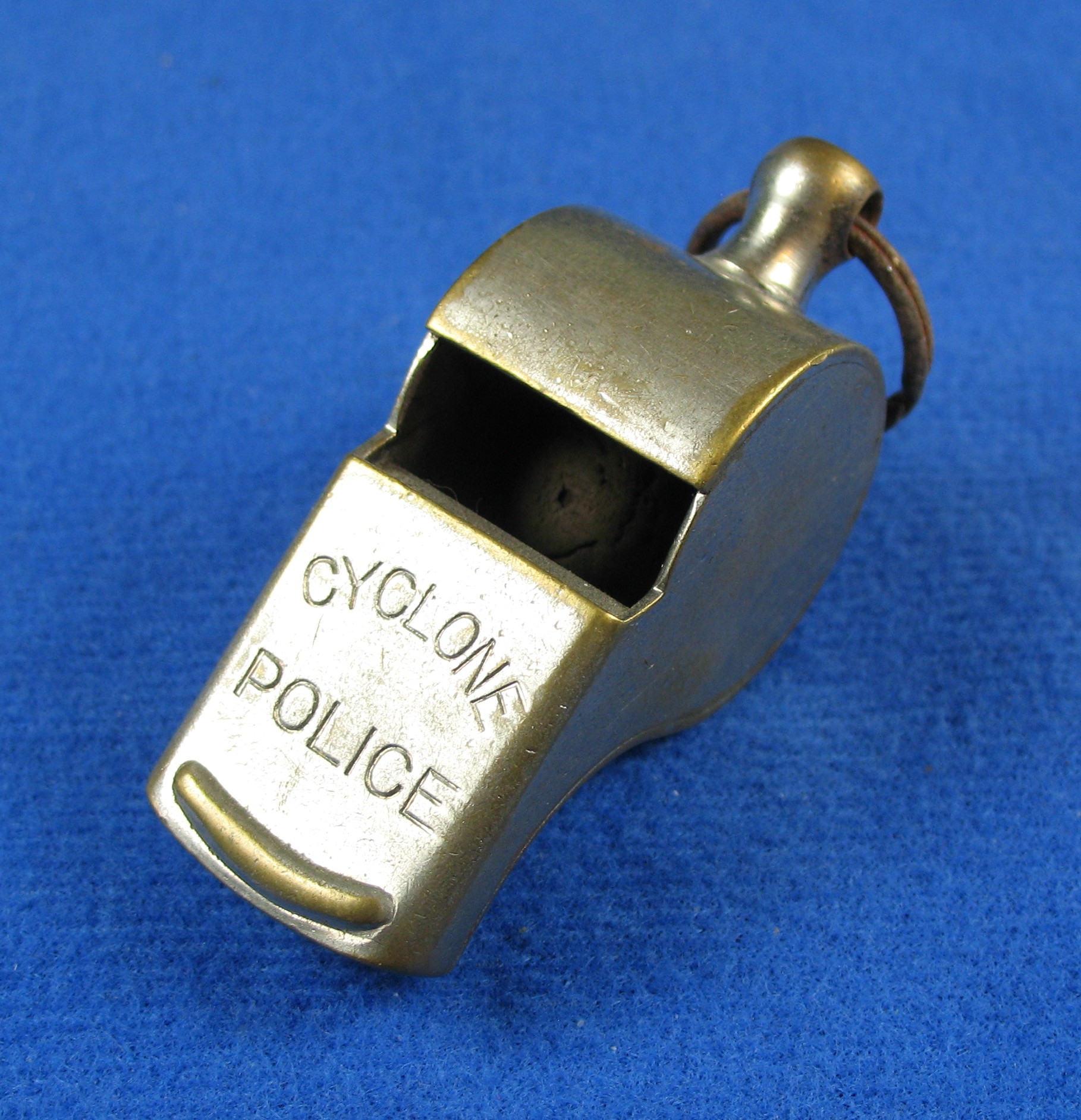
During the early 1920s the top cap with a groove was patented by Joseph Hudson in the UK. At some point the round knop gave way to the same concept in the states. B&R went to this model and stayed with it until World War 2 as follows.
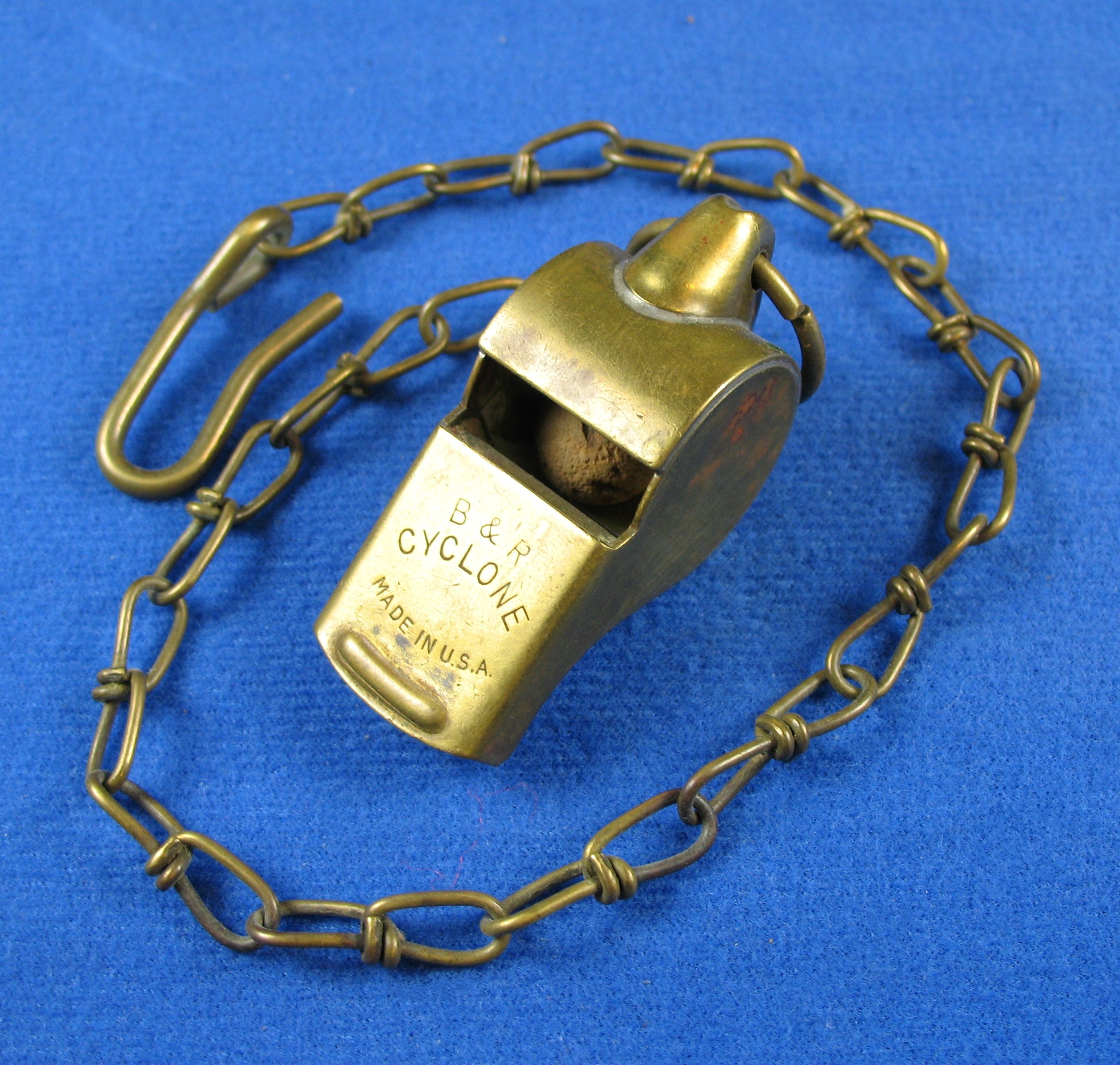
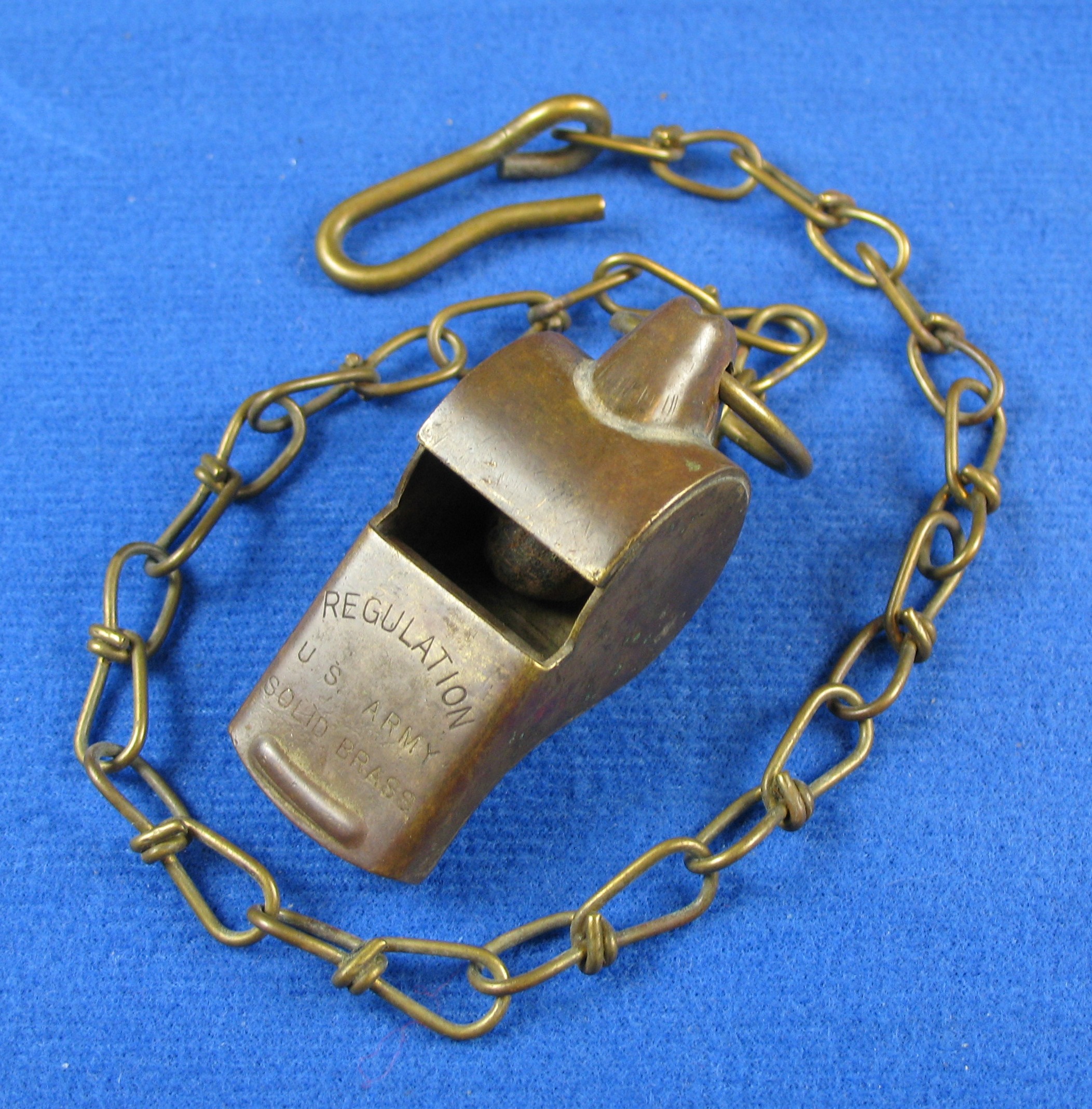
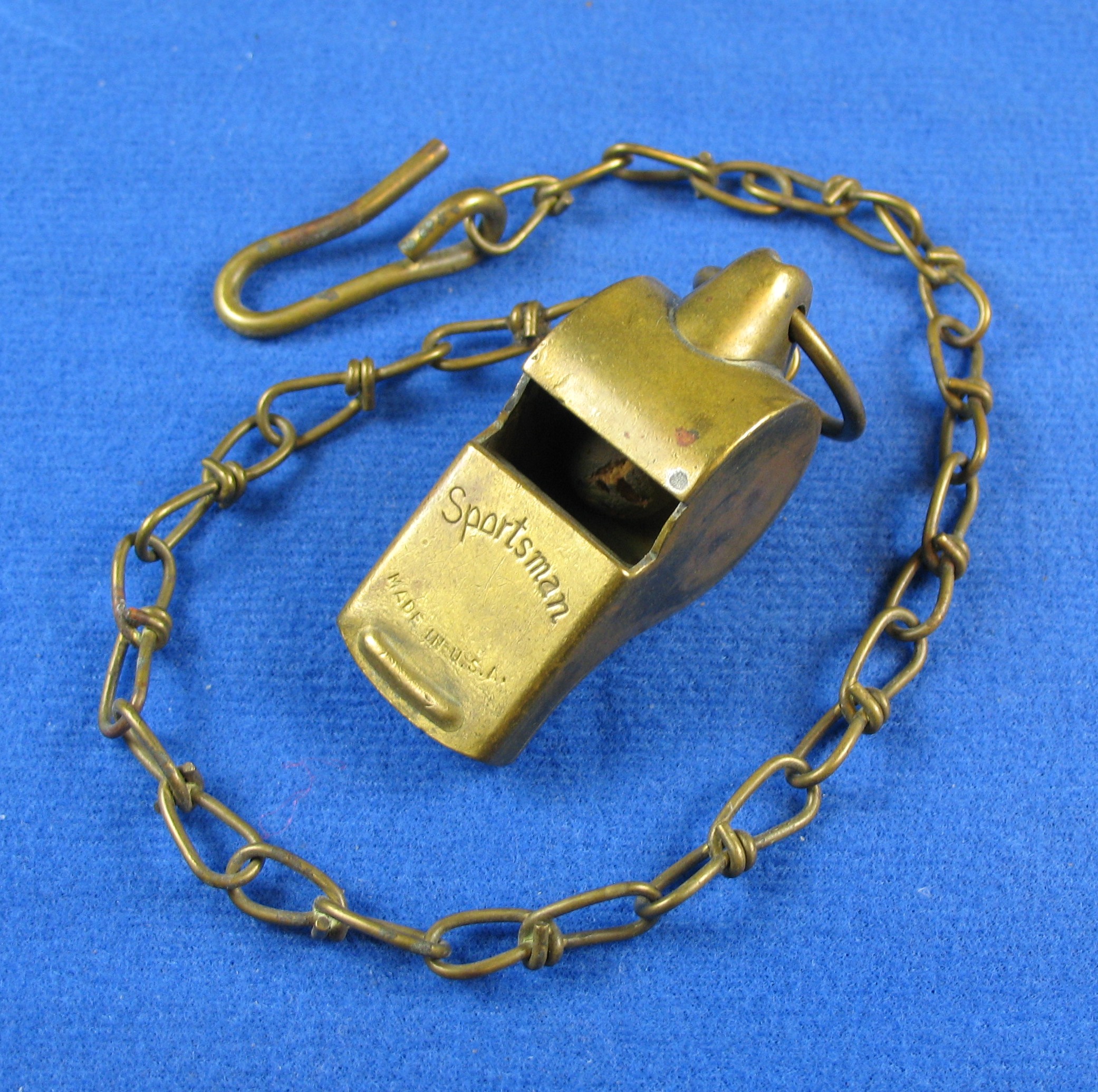
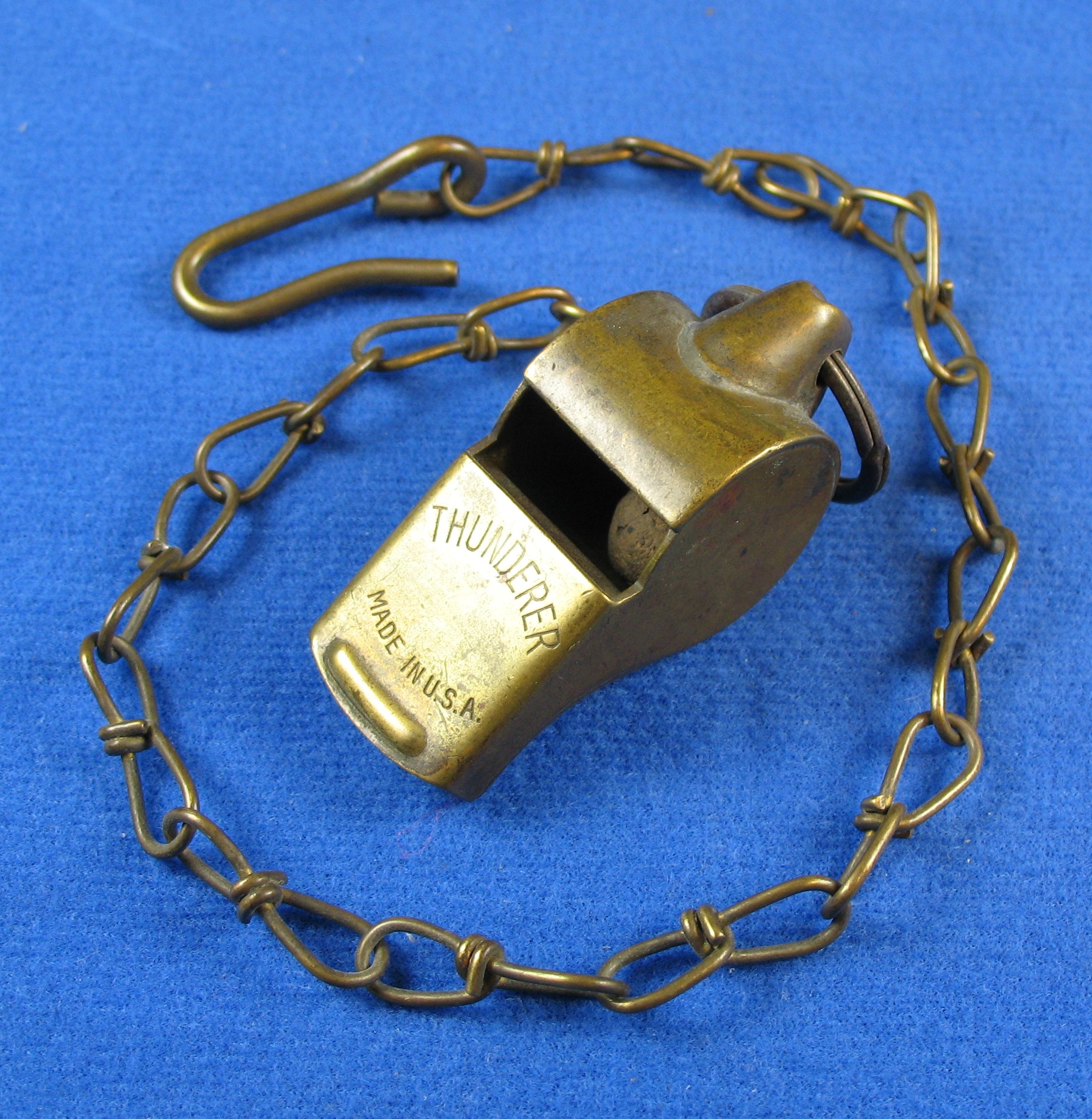
This USA escargot matches B&R construction just prior to world war two. Note the distinctive change in the top cap. The stamp matches as well, as the tongue construction inside the mouthpiece.
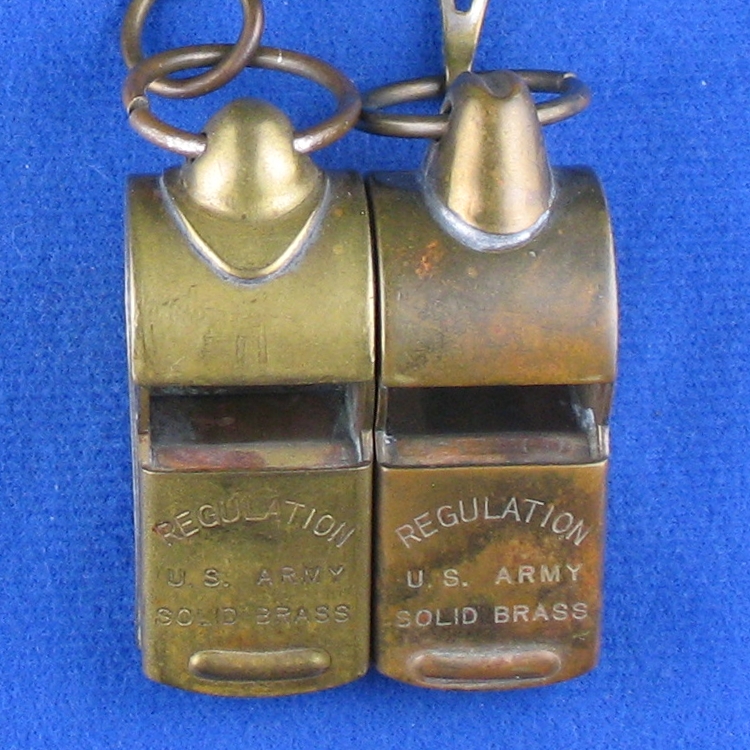
As this subject opens up now other B&R whistles can now be identified. The next unstamped escargot takes us a bit further.
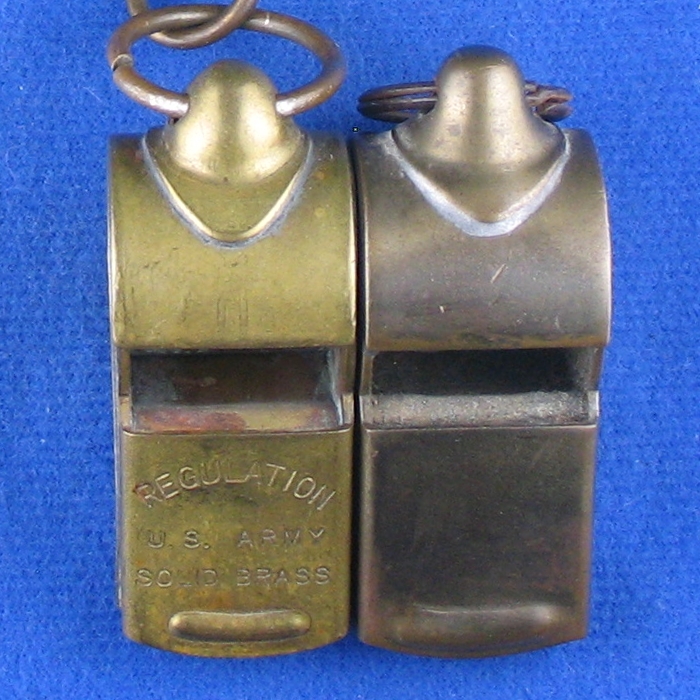
Now note the two types of escargots with different top caps side by side.
Each has the same tongue which is distinctive to B&R.
Escargot tongues are a very helpful identifying feature.
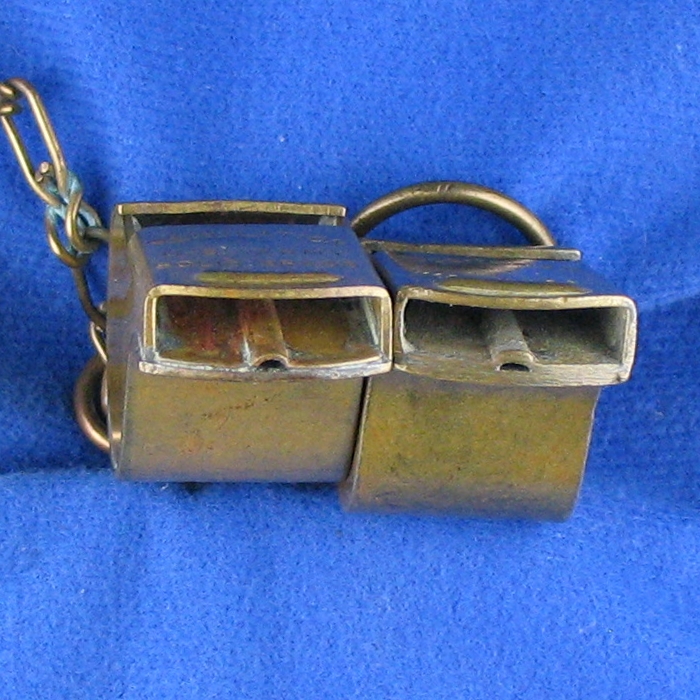
A matching whistle with a Vietnamese stamp has now been seen and recorded with the matching top cap and tongue as seen below.
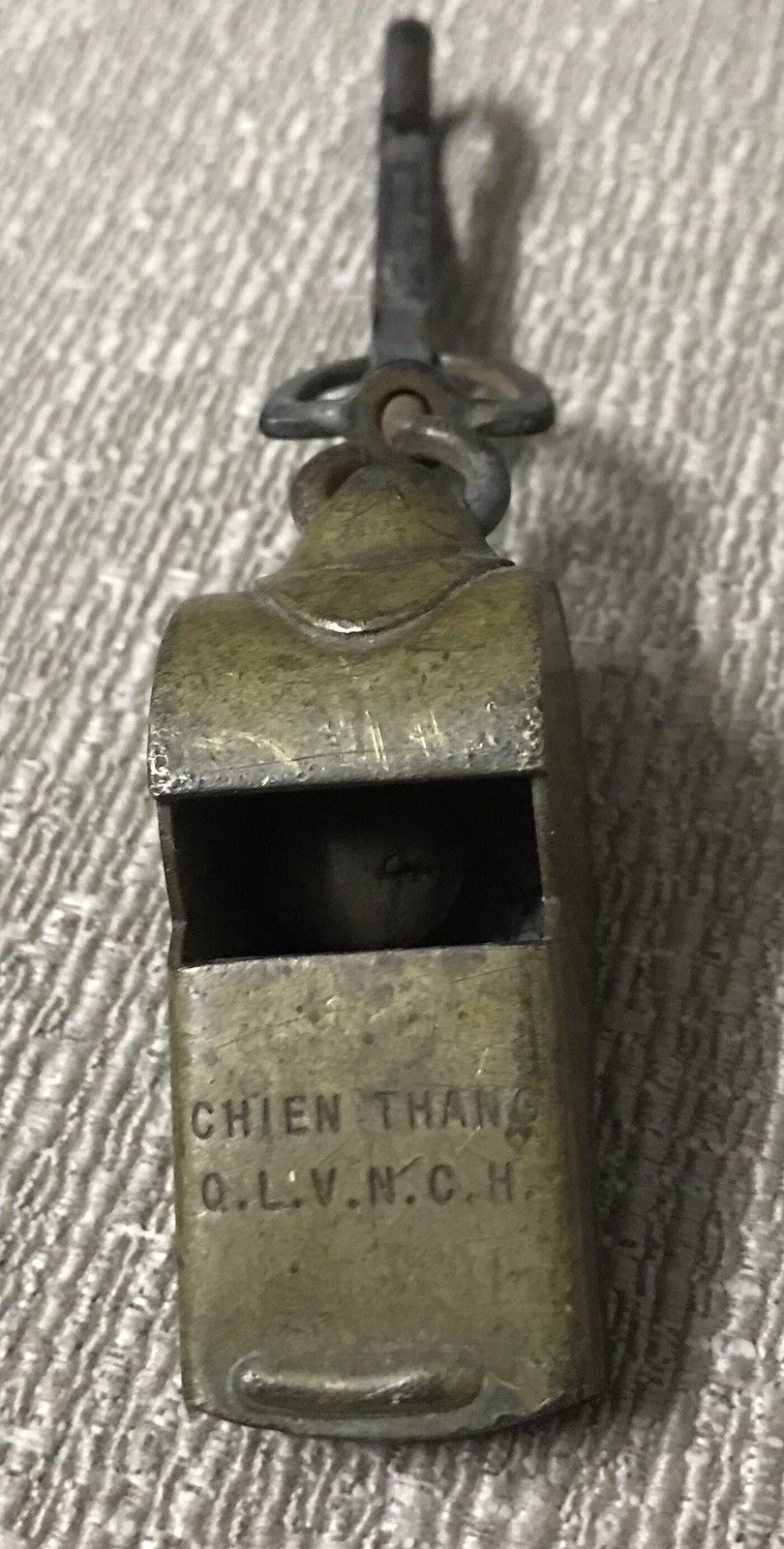
Photo Credit Unknown
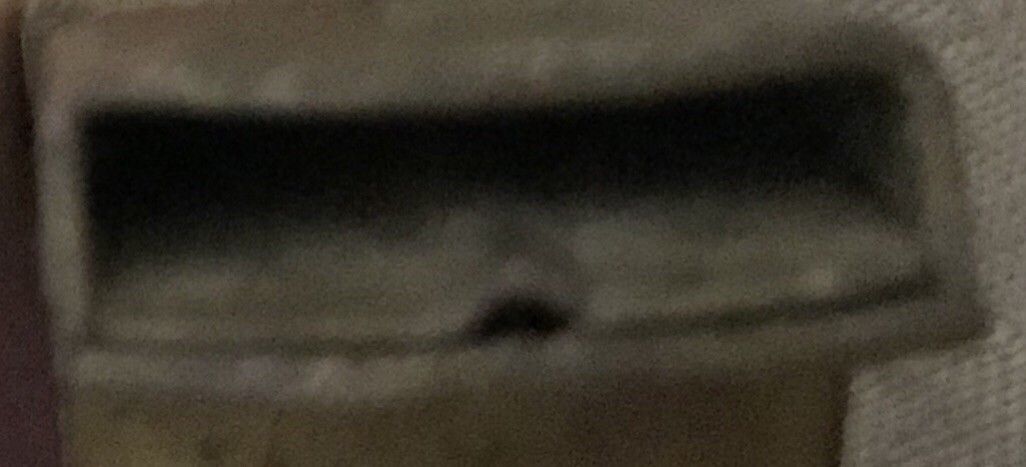
Photo Credit Unknown
When we examine the escargots c. 1910 ( with round spherical knops ) then we see a flat tongue placed alongside the ‘humpback’ top caps c. 1940 we see that the tongues have a high middle groove.
Here is one of each and for a close comparison.
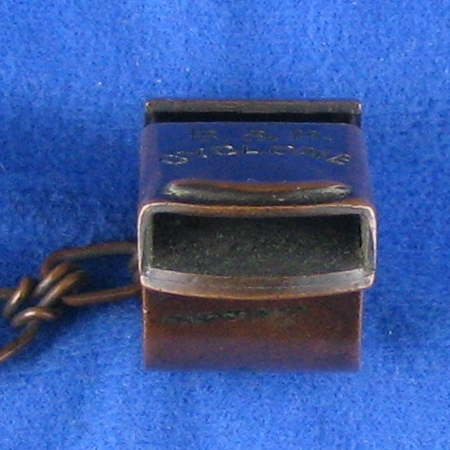
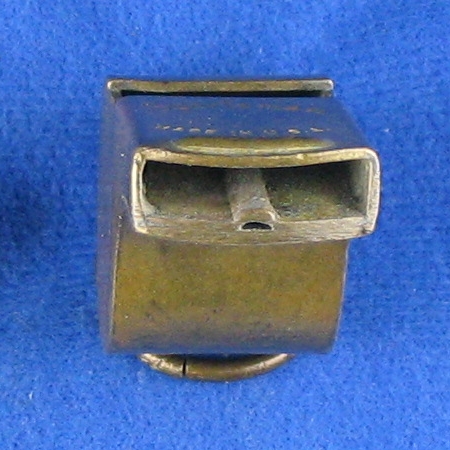
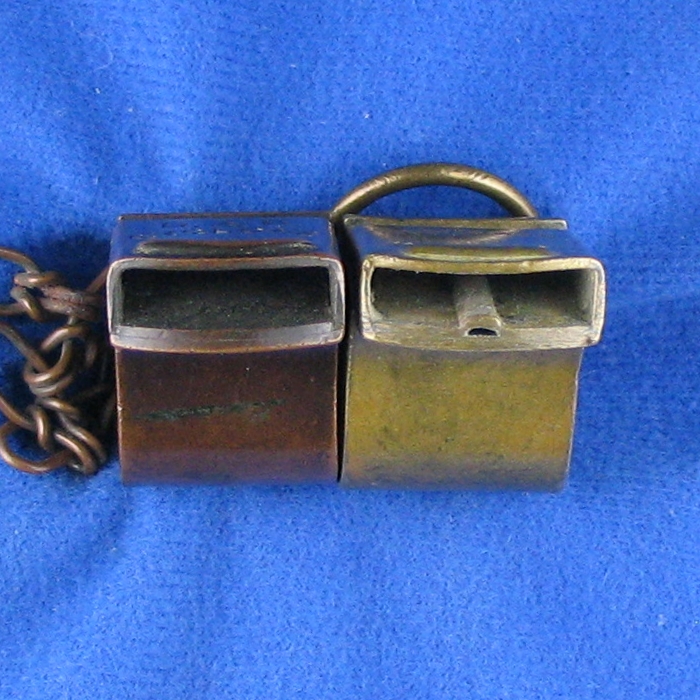
Thin wall sirens by B&R — and again may well have been made by the Waterbury Manufacturing Co. However, the original patent of 1895 by Mossberg and Wardwell was assigned to the Mossberg Wrench Company. Perhaps B&R ordered sirens from them as well.
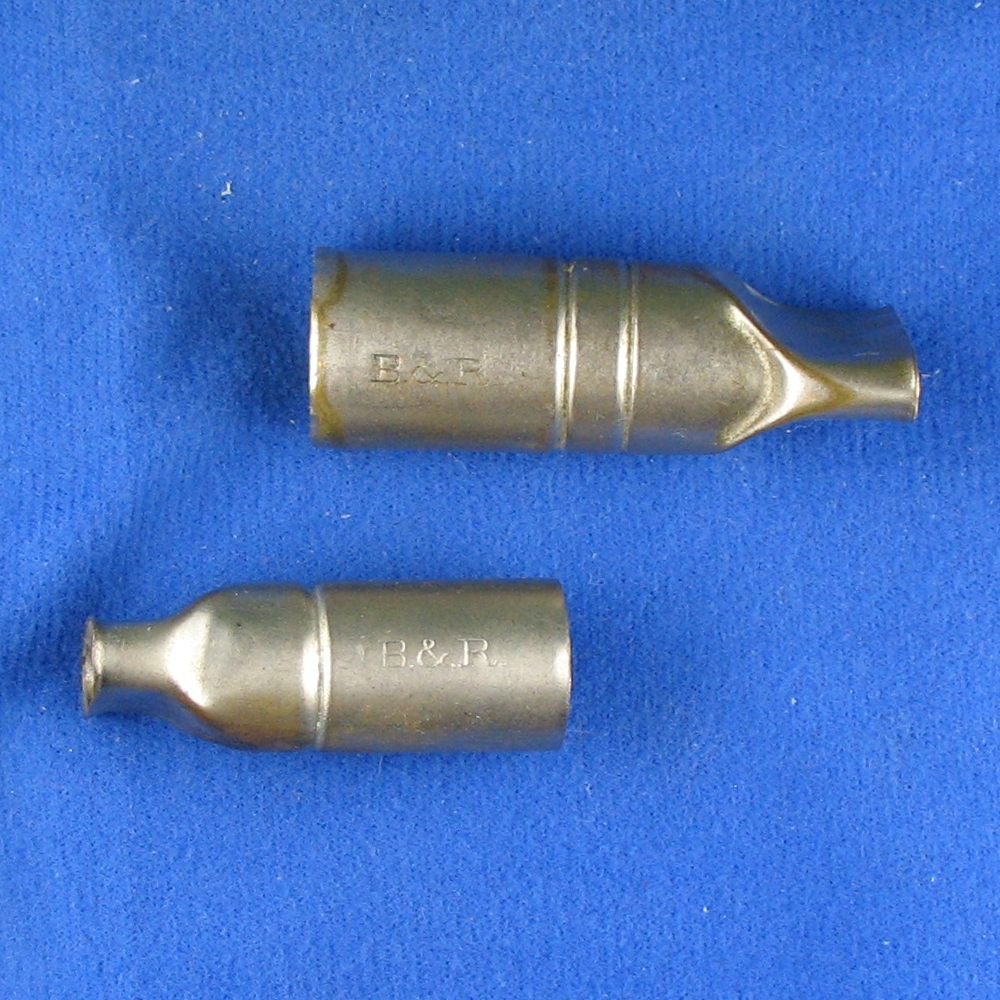
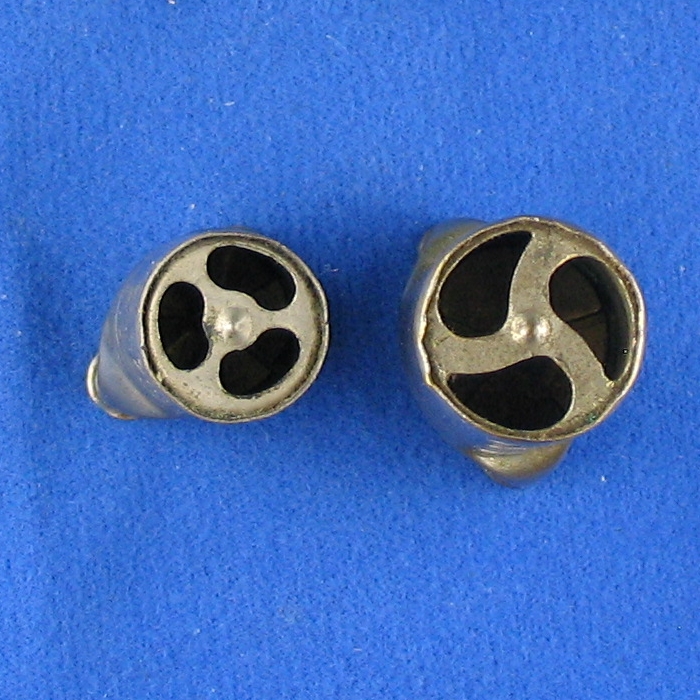
Probably B&R was best known for their very heavy tube shaped whistles dating back to 1910. They are very close to German made whistles of that era; however the top and mouthpieces were not made of lead. We find the same model with at least six different stamps. Pictured here are all six known.
The top caps are very heavy cast. The mouthpieces are turned on lathes, machined out.
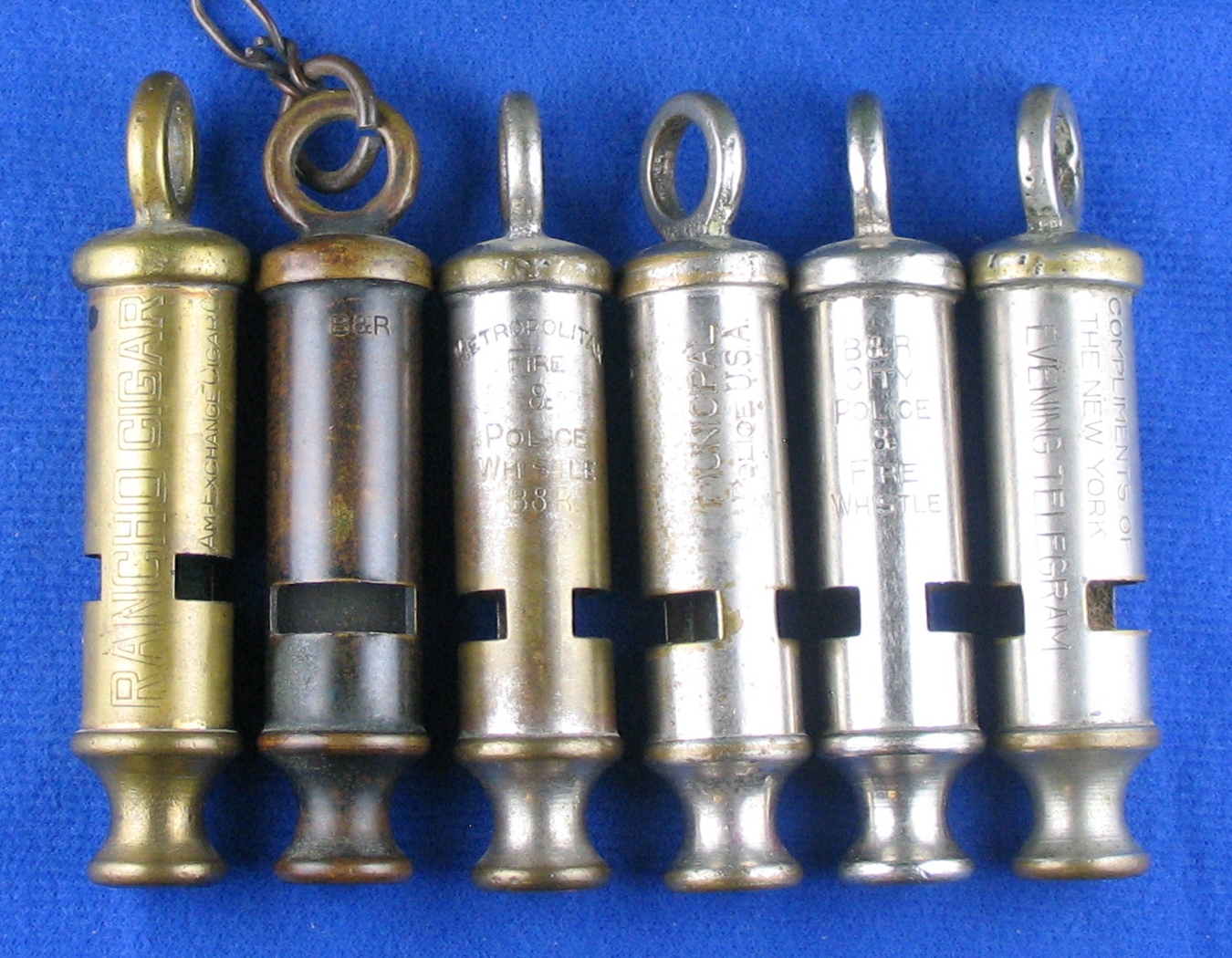
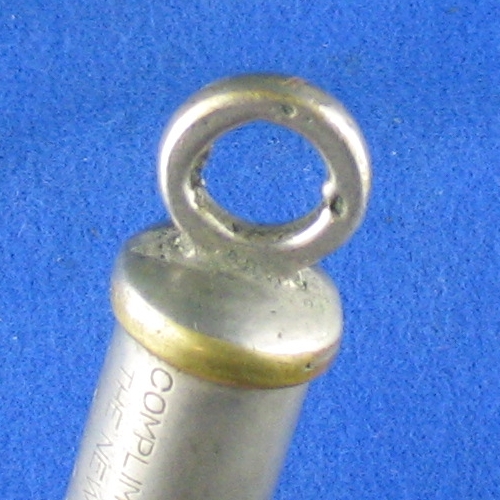
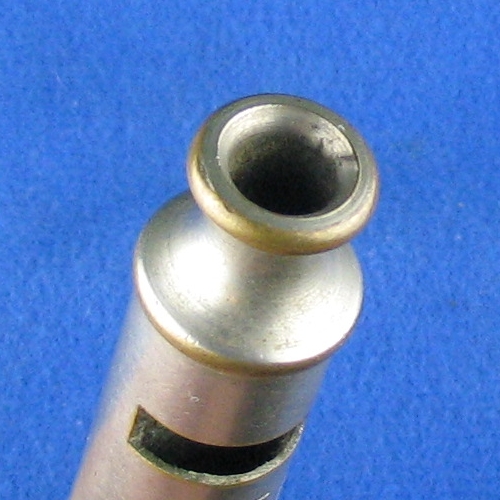
As of writing this article a Burt patent design whistle surfaced with the stamp matching these heavy tube whistles, although the top cap is lighter as well as the mouthpiece.
Note the top is closer to an O’Reilly patent whistle; however the inside has the Burt attachment at the disc.
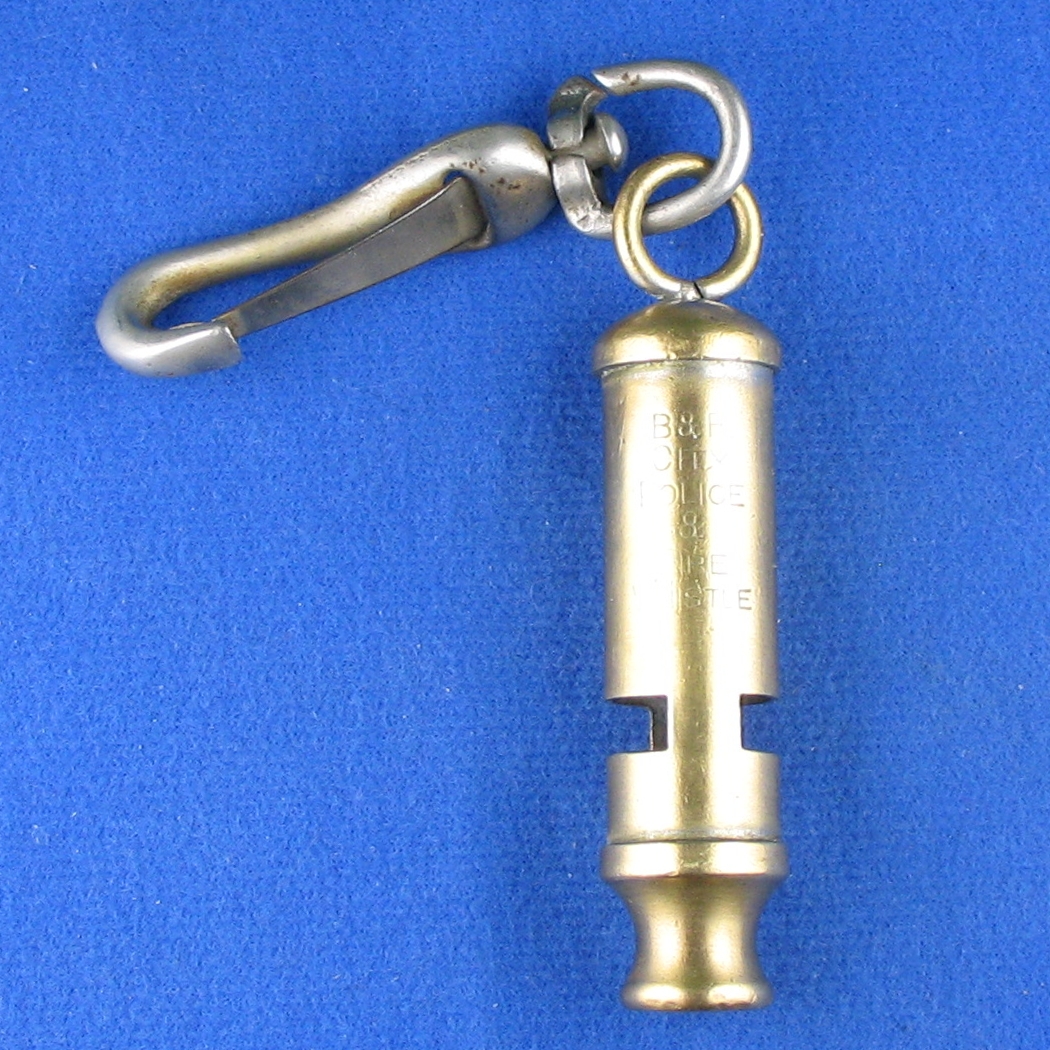
Yet, as you can see the stamps are matching.
Did Waterbury manufacture this whistle ??
Did they make both whistle models ??
Compare them side by side.
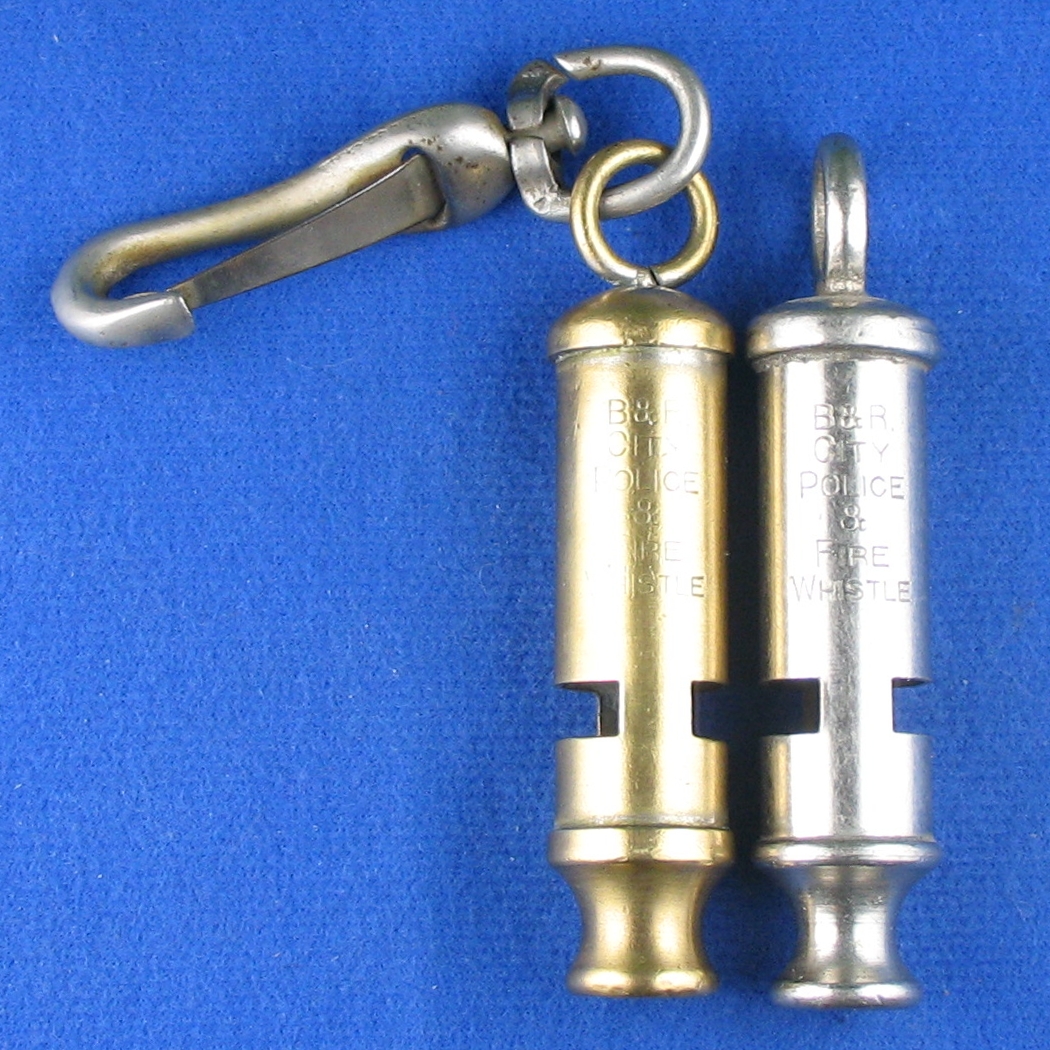
B&R also sold duplex and triplex metal whistles. The duplex has been found with and without the B&R stamp; the triplex matches well, but has not been found with the stamp of B&R. The serrated teeth were seen primarily inside Banks and Brother’s whistles as late as circa 1910 and are now seen on B&R duplex and triplex from about this time period onward.
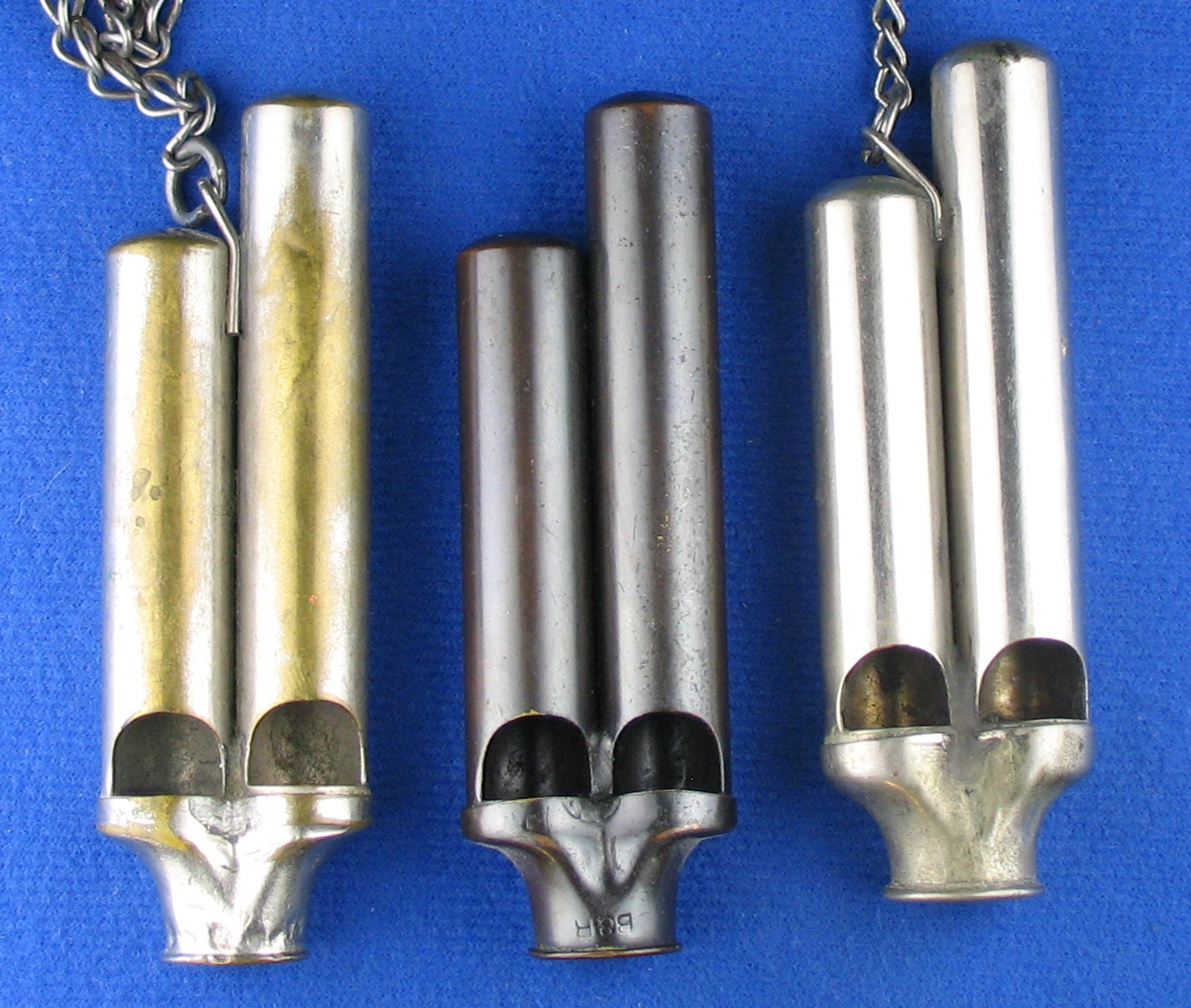
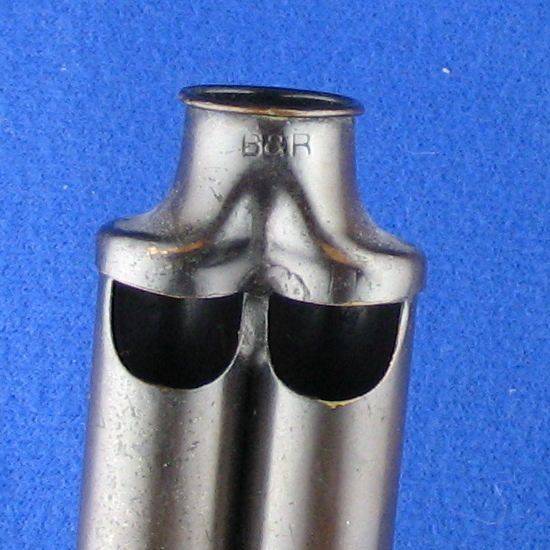
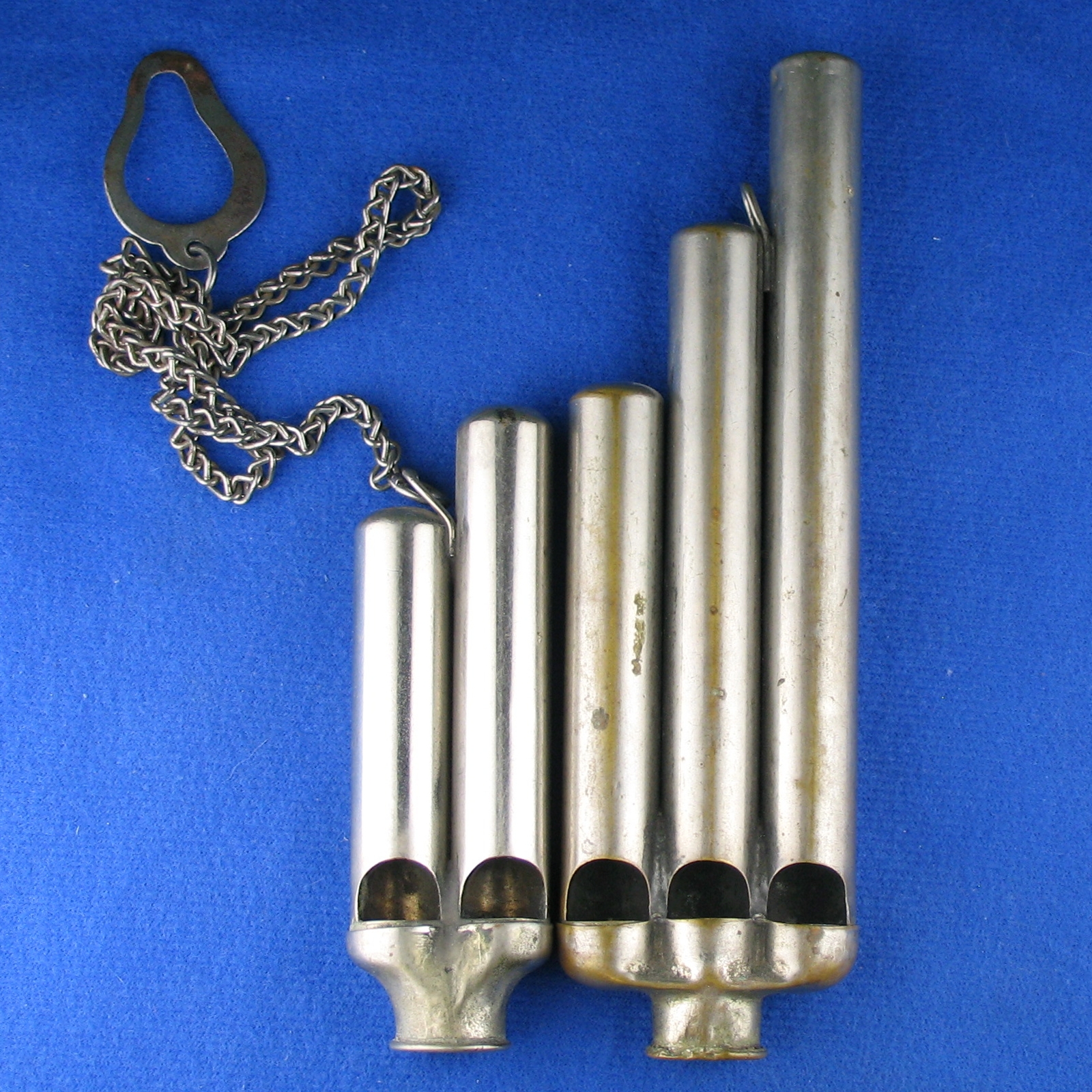
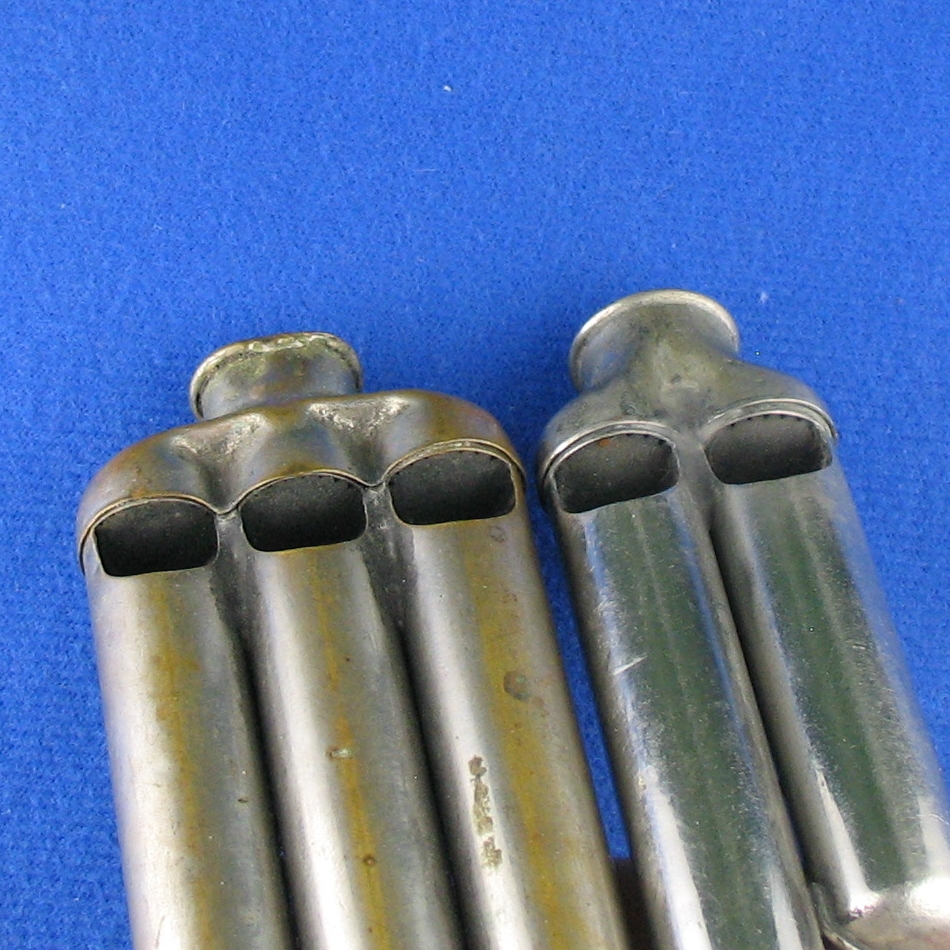
The top cap escargots with and without grooves, metal sirens, duplex and triplex as well as heavy tube whistles ceased circa World War 2. The company appears to have changed ownership and also specific drawn B&R stamps. Perhaps post war markets opened up, labor was less overseas or the original supplier ( Waterbury ?? ) ceased being suppliers’. With post war demands down or shifted, Waterbury did close down much of its brass production. Whatever the causes, whistles from B&R appear to have changed materials, workmanship and even the B&R stamp design.
That being the case, at this point we have recorded a Japanese manufactured B&R model. Did they go to overseas manufacturer in the later years ??
This one has a pointed top matching other Japanese escargots of this manufacturer which were much lighter in construction.
One sees the close stamping of "B&R", but now the word "WHISTLES" is added.
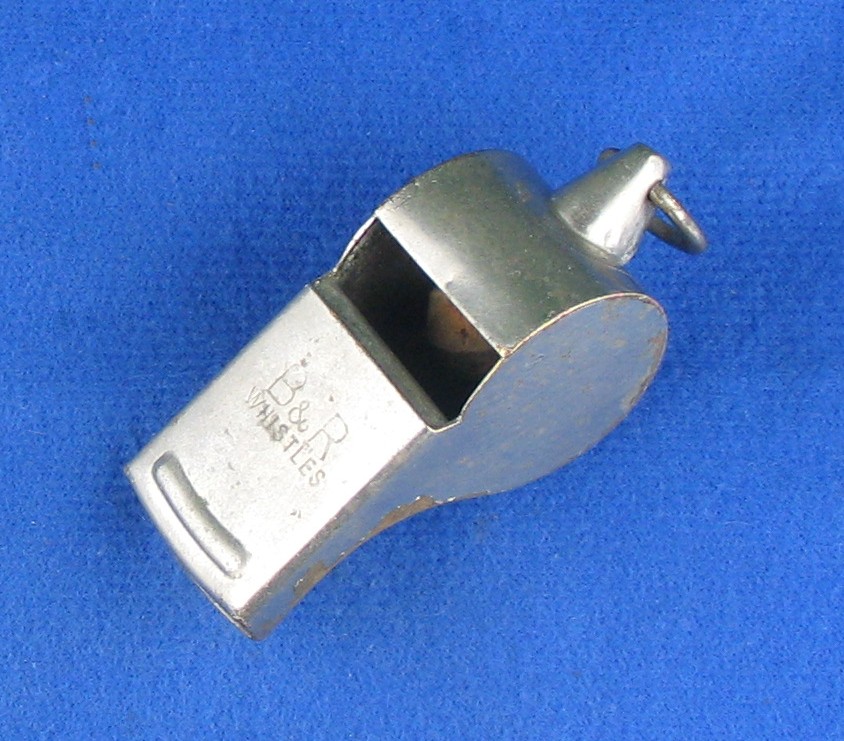
The next one is B&R Jerry No 2550 that is closely following the BGI model 601 escargot of circa 1900, which looks to possibly be Japanese construction, especially the under supports.
This is followed by a zinc with a plated escargot, which is possibly Japanese manufacturing also.
All three circa 1950 ??
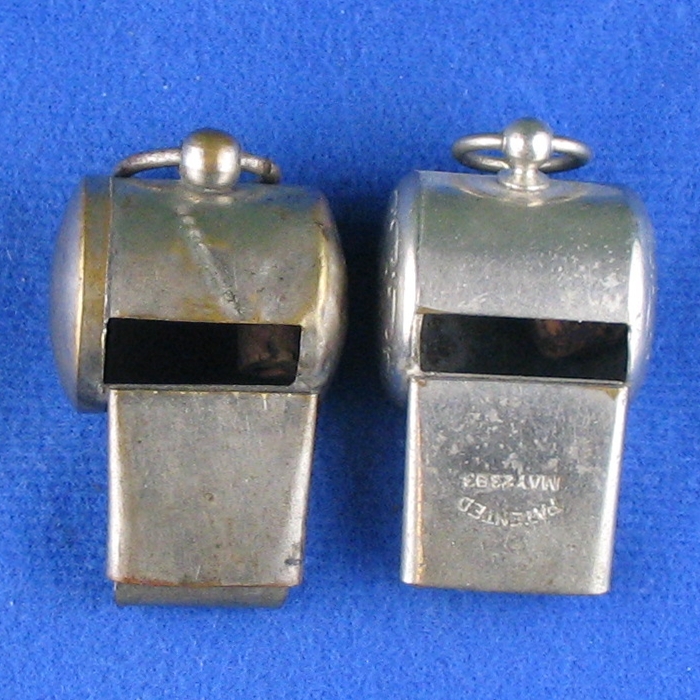
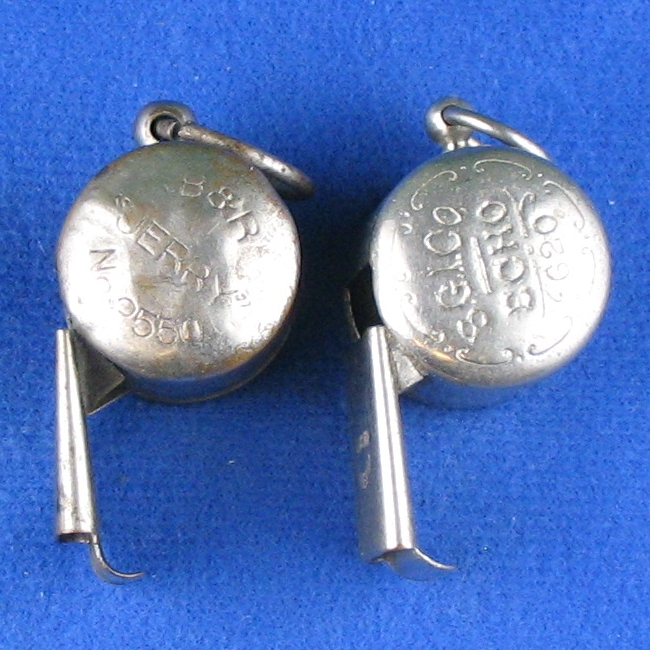
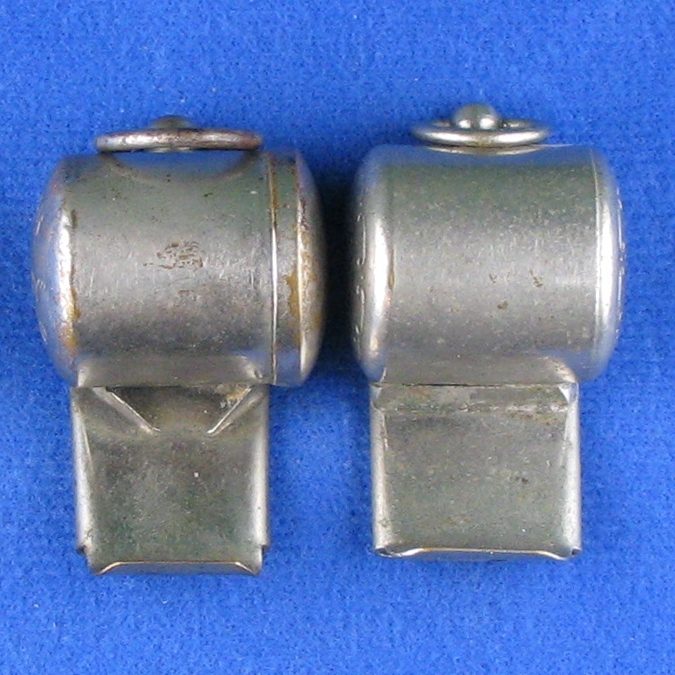
In the following escargots, there is discernable German influence.
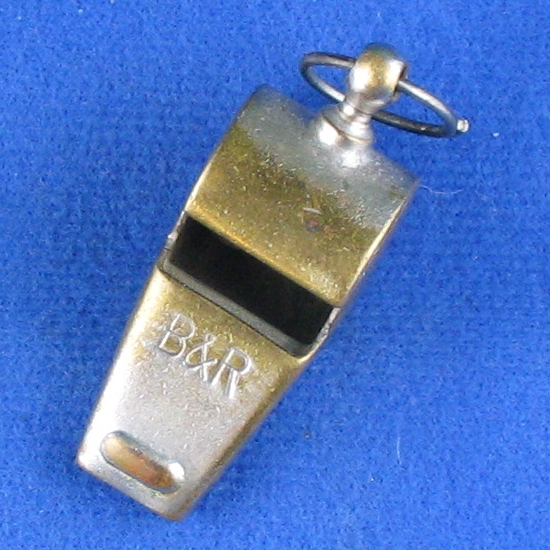
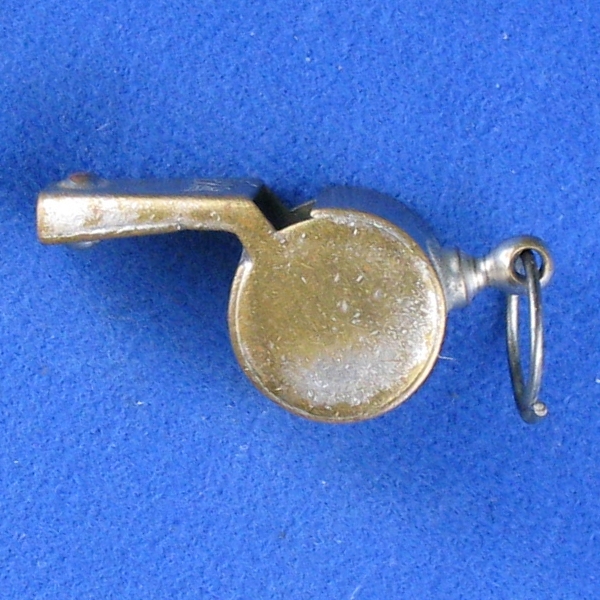
The following plastic duplex and triplex whistles were recorded from online auctions.
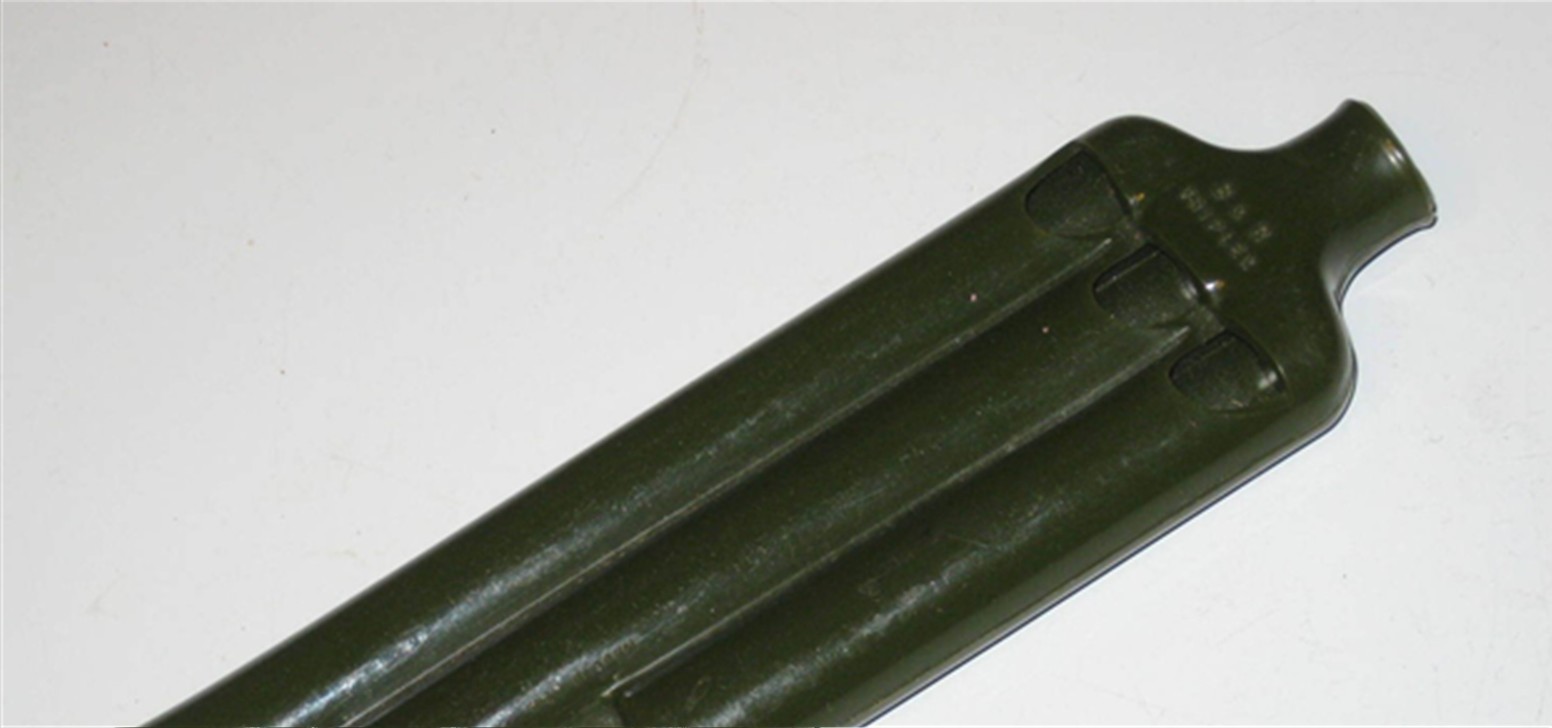
Photo Credit Unknown
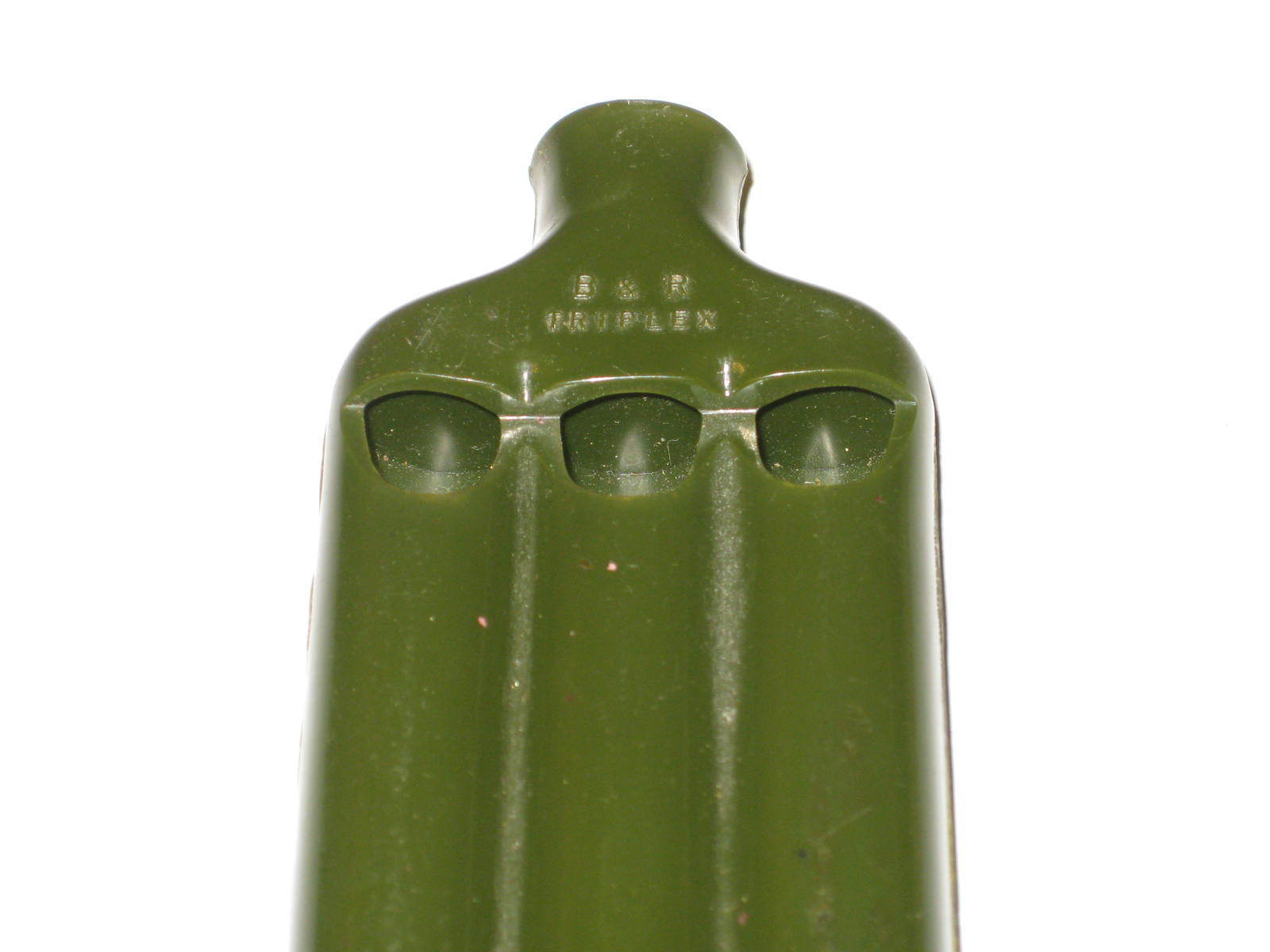
Photo Credit Unknown
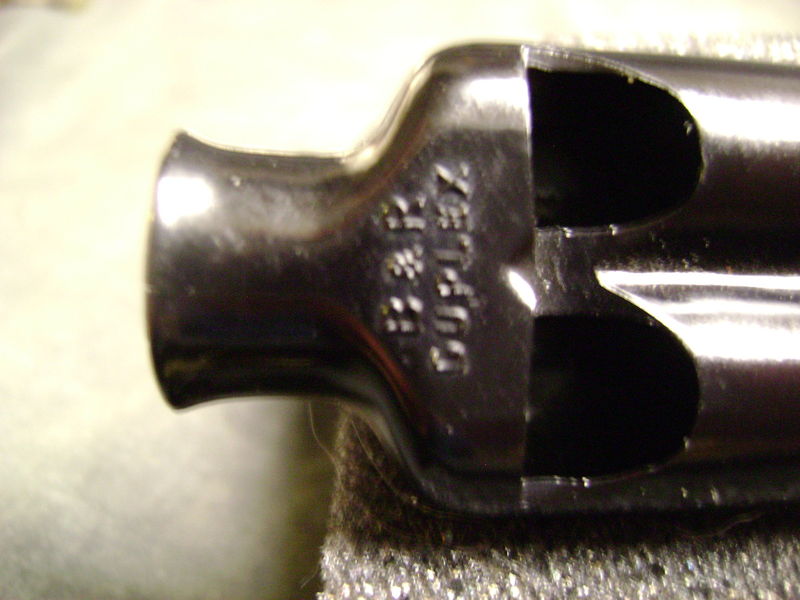
Photo Credit Unknown
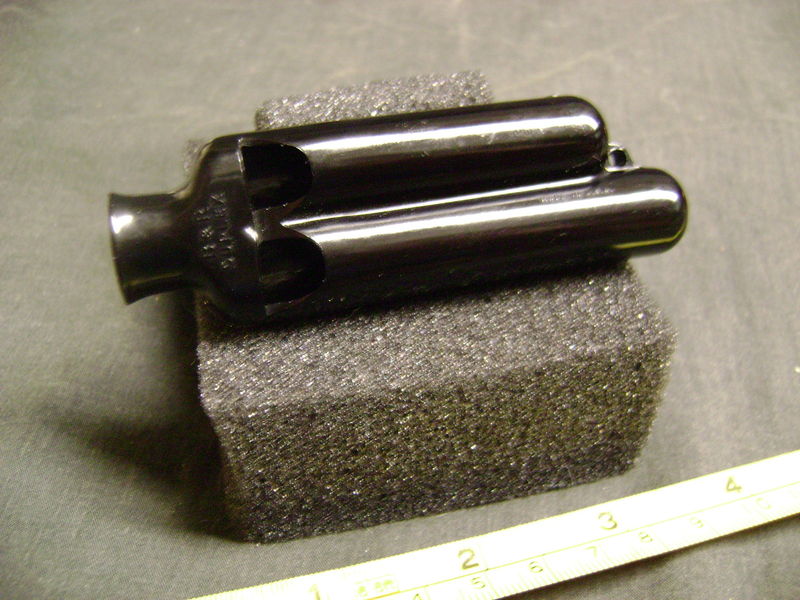
Photo Credit Unknown
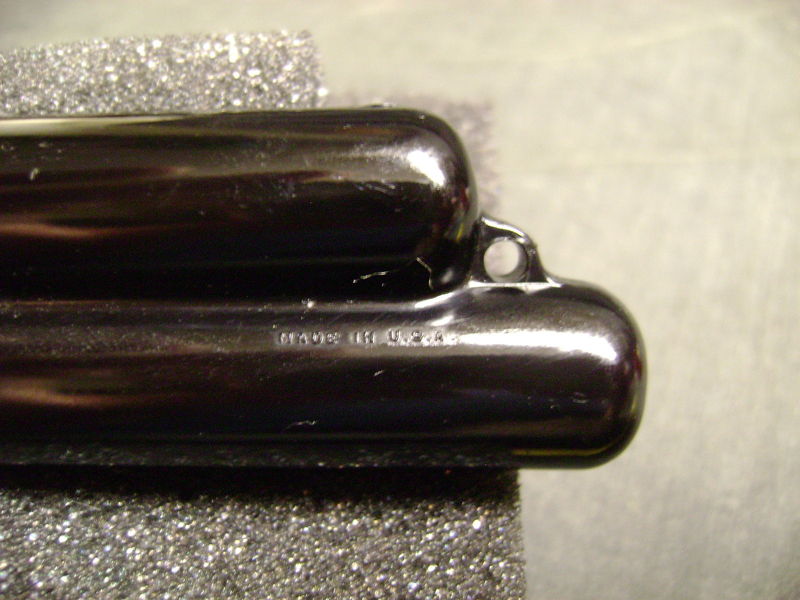
Photo Credit Unknown
Closing Questions:
- Did B&R contract ALL their whistles ??
- How many sources were used at first ?? ( Waterbury, Gotham, Tower Hardware, etc. )
- Did B&R contract out later post WW2 ??
- Who did they contract to ??
– TWG
Posted April 16, 2018
BIBIOGRAPHY:
The Official Handbook for Boys page 406, 1911-13
Boy’s Life 1913
Official Gazette of the US patent Office 1911
Polks’ (TROW) New York Copartnership and corporation directory 1910
The Billboard March 14, 1953
Notions and Goods Vol 40. Pg. 63
Trow’s directory Copartnership and Corporation March 1900
